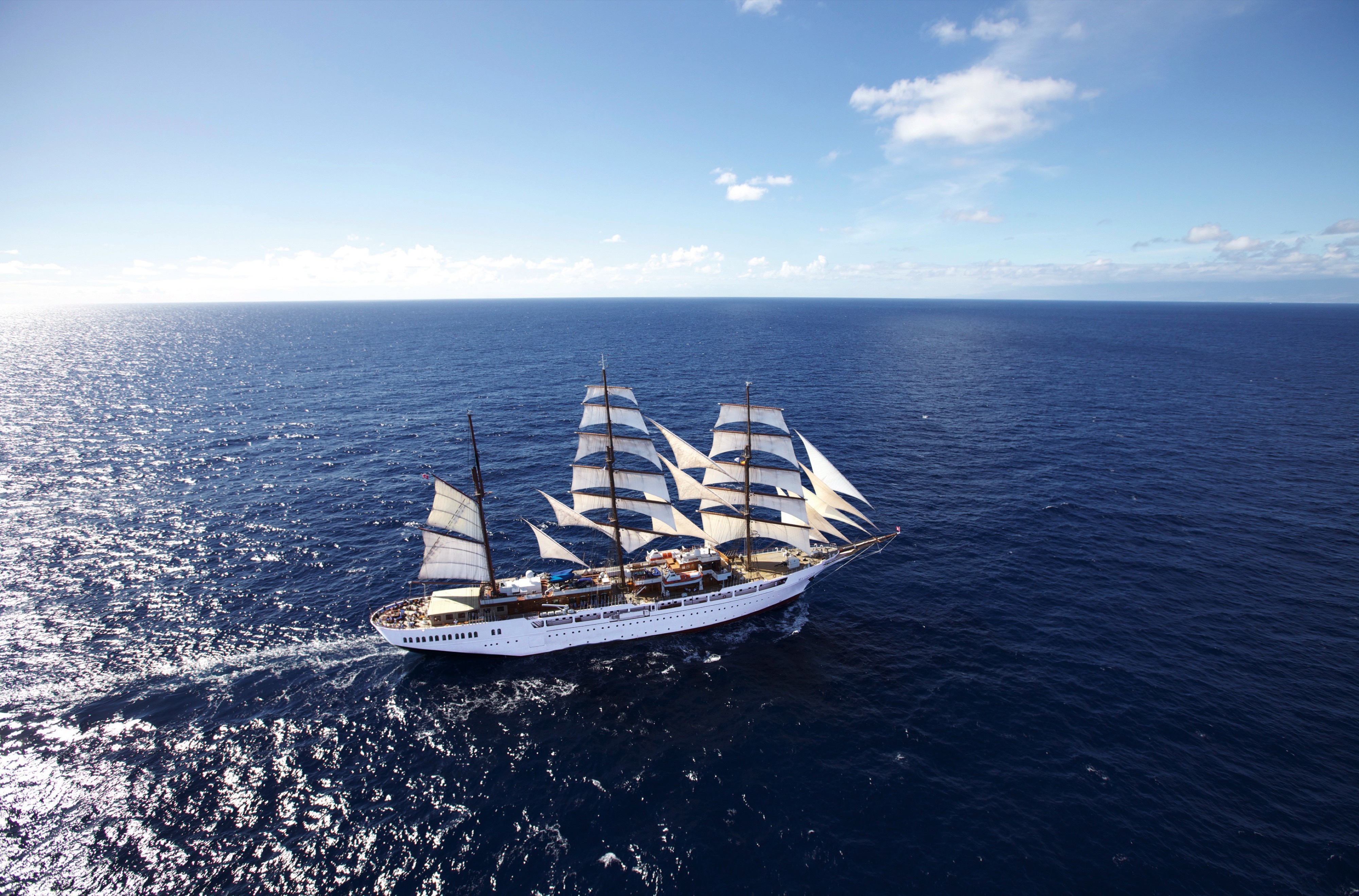Itinerary
Livorno is a gritty city with a long and interesting history. In the early Middle Ages it alternately belonged to Pisa and Genoa. In 1421 Florence, seeking access to the sea, bought it. Cosimo I (1519–74) started construction of the harbor in 1571, putting Livorno on the map. After Ferdinando I de’ Medici (1549–1609) proclaimed Livorno a free city, it became a haven for people suffering from religious persecution; Roman Catholics from England and Jews and Moors from Spain and Portugal, among others, settled here. The Quattro Mori (Four Moors), also known as the Monument to Ferdinando I, commemorates this. (The statue of Ferdinando I dates from 1595, the bronze Moors by Pietro Tacca from the 1620s.)In the following centuries, and particularly in the 18th, Livorno boomed as a port. In the 19th century the town drew a host of famous Britons passing through on their grand tours. Its prominence continued up to World War II, when it was heavily bombed. Much of the town’s architecture, therefore, postdates the war, and it’s somewhat difficult to imagine what it might have looked like before. Livorno has recovered from the war, however, as it’s become a huge point of departure for container ships, as well as the only spot in Tuscany for cruise ships to dock for the day.Most of Livorno’s artistic treasures date from the 17th century and aren’t all that interesting unless you dote on obscure baroque artists. Livorno’s most famous native artist, Amedeo Modigliani (1884–1920), was of much more recent vintage. Sadly, there’s no notable work by him in his hometown.There may not be much in the way of art, but it’s still worth strolling around the city. The Mercato Nuovo, which has been around since 1894, sells all sorts of fruits, vegetables, grains, meat, and fish. Outdoor markets nearby are also chock-full of local color. The presence of Camp Darby, an American military base just outside town, accounts for the availability of many American products.If you have time, Livorno is worth a stop for lunch or dinner at the very least.
Located in the South of Corsica, Bonifacio is one of the island’s most beautiful destinations. From its breathtaking views and sandy white islands to its historic citadel, the city is a must visit for anyone travelling to the island.
Considered Corsica’s primary commercial and cultural hub, the largest city and regional capital of Ajaccio is situated on the west coast of the island, approximately 644 km (400 miles) southeast of Marseille, France. Founded in 1492, vestiges of ancient Corsica in this ville impériale revolve around the city’s most famous son, Napoléon Bonaparte, whose family home—now the national museum Maison Bonaparte—pays tribute to the emperor’s historical influence.Remnants from what was originally a 12th-century Genoese colony are still visible around the Old Town near the imposing citadel and watchtower. Perfect for exploring, the luminous seaside city surrounded by snowcapped mountains and pretty beaches offers numerous sites, eateries, side streets, and a popular harbor, where sailboats and fishing vessels moor in the picturesque Tino Rossi port lined with well-established restaurants and cafés serving fresh local fare.
“Where the mountains meet the sea,” the beautiful island of Corsica, set in the blue waters of the Mediterranean between Italy and France, is steeped in history. Ile Rousse is built on the site of an old roman settlement. She rivals Calvi as a seaside resort, with nice sandy beaches and good accommodation facilities. The port of Ile Rousse was built by Pasquale Paoli –most famous Corsican Patriot-in 1758 to replace Calvi, still in Genoese hands, has taken the place of first port in this region for exporting fresh fruit and olive oil. The harbour is located on an peninsula, red coloured rock, that just comes out of the sea hence the name of Ile Rousse which means “ reddish island”. There is a lighthouse at the outer end of the island with an old ruined tower. Returning to the mainland a street leads from port to town centre along a nice sandy beach, towards the main square Place Paoli. In the middle of the square there is a statue of Pascal Paoli. During Summer season, the square surrounded by palm trees welcomes numerous tourists looking for some shade and refreshing ice cream. The old market situated in the middle of the town, faced to the Paoli square, offers a large choice of fresh fruits and veggies as well as fish from the catch of the day, or a sample of the famous Corsican delicatessen, cheeses, honeys and wines.
Elba is the Tuscan archipelago’s largest island, but it resembles nearby verdant Corsica more than it does its rocky Italian sisters, thanks to a network of underground springs that keep it lush and green. It’s this combination of semitropical vegetation and dramatic mountain scenery—unusual in the Mediterranean—that has made Elba so prized for so long, and the island’s uniqueness continues to draw boatloads of visitors throughout the warm months. A car is very useful for getting around the island, but public buses stop at most towns several times a day; the tourist office has timetables.
One of the most photographed villages along the coast, with a decidedly romantic and affluent aura, Portofino has long been a popular destination for the rich and famous. Once an ancient Roman colony and taken by the Republic of Genoa in 1229, it’s also been ruled by the French, English, Spanish, and Austrians, as well as by marauding bands of 16th-century pirates. Elite British tourists first flocked to the lush harbor in the mid-1800s. Some of Europe’s wealthiest drop anchor in Portofino in summer, but they stay out of sight by day, appearing in the evening after buses and boats have carried off the day-trippers.There’s not actually much to do in Portofino other than stroll around the wee harbor, see the castle, walk to Punta del Capo, browse at the pricey boutiques, and sip a coffee while people-watching. However, weaving through picture-perfect cliffside gardens and gazing at yachts framed by the sapphire Ligurian Sea and the cliffs of Santa Margherita can make for quite a relaxing afternoon. There are also several tame, photo-friendly hikes into the hills to nearby villages.Unless you’re traveling on a deluxe budget, you may want to stay in Camogli or Santa Margherita Ligure rather than at one of Portofino’s few very expensive hotels. Restaurants and cafés are good but also pricey (don’t expect to have a beer here for much under €10).
On one of the best stretches of the Mediterranean, this classic luxury destination is one of the most sought-after addresses in the world. With all the high-rise towers you have to look hard to find the Belle Époque grace of yesteryear. But if you head to the town’s great 1864 landmark Hôtel de Paris—still a veritable crossroads of the buffed and befurred Euro-gentry—or enjoy a grand bouffe at its famous Louis XV restaurant, or attend the opera, or visit the ballrooms of the casino, you may still be able to conjure up Monaco’s elegant past. Prince Albert II, a political science graduate from Amherst College, traces his ancestry to Otto Canella, who was born in 1070. The Grimaldi dynasty began with Otto’s great-great-great-grandson, Francesco Grimaldi, also known as Frank the Rogue. Expelled from Genoa, Frank and his cronies disguised themselves as monks and in 1297 seized the fortified medieval town known today as Le Rocher (the Rock). Except for a short break under Napoléon, the Grimaldis have been here ever since, which makes them the oldest reigning family in Europe. In the 1850s a Grimaldi named Charles III made a decision that turned the Rock into a giant blue chip. Needing revenue but not wanting to impose additional taxes on his subjects, he contracted with a company to open a gambling facility. The first spin of the roulette wheel was on December 14, 1856. There was no easy way to reach Monaco then—no carriage roads or railroads—so no one came. Between March 15 and March 20, 1857, one person entered the casino—and won two francs. In 1868, however, the railroad reached Monaco, and it was filled with Englishmen who came to escape the London fog. The effects were immediate. Profits were so great that Charles eventually abolished all direct taxes. Almost overnight, a threadbare principality became an elegant watering hole for European society. Dukes (and their mistresses) and duchesses (and their gigolos) danced and dined their way through a world of spinning roulette wheels and bubbling champagne—preening themselves for nights at the opera, where such artists as Vaslav Nijinsky, Sarah Bernhardt, and Enrico Caruso came to perform. Along with the tax system, its sensational position on a broad, steep peninsula that bulges into the Mediterranean—its harbor sparkling with luxury cruisers, its posh mansions angling awnings toward the nearly perpetual sun—continues to draw the rich and famous. One of the latest French celebrities to declare himself “Monégasque,” thus giving up his French passport, is superchef Alain Ducasse, who said that he made the choice out of affection for Monaco rather than tax reasons. Pleasure boats vie with luxury cruisers in their brash beauty and Titanic scale, and teams of handsome young men—themselves dyed blond and tanned to match—scour and polish every gleaming surface. As you might expect, all this glitz doesn’t come cheap. Eating is expensive, and even the most modest hotels cost more here than in nearby Nice or Menton. As for taxis, they don’t even have meters so you are completely at the driver’s mercy (with prices skyrocketing during events such as the Grand Prix). For the frugal, Monaco is the ultimate day-trip, although parking is as coveted as a room with a view. At the very least you can afford a coffee at Starbucks. The harbor district, known as La Condamine, connects the new quarter, officially known as Monte Carlo with Monaco-Ville (or Le Rocher), a medieval town on the Rock, topped by the palace, the cathedral, and the Oceanography Museum. Have no fear that you’ll need to climb countless steps to get to Monaco-Ville, as there are plenty of elevators and escalators climbing the steep cliffs. But shuttling between the lovely casino grounds of Monte Carlo and Old Monaco, separated by a vast port, is a daunting proposition for ordinary mortals without wings, so hop on the No. 1 bus from Saint Roman, or No. 2 from the Jardin Exotique – Both stop at Place du Casino and come up to Monaco Ville.
United with France only since 1860, Nice has its own history and atmosphere, which dates back 230,000 years. It was on Colline du Château (now château-less) and at the Plage des Ponchettes, in front of the Old Town, that the Greeks established a market-port in 350 BC and named it Nikaia, which would become Marseilles’ chief coastal rival. The Romans established themselves a little later on the hills of Cimiez (Cemenelum), already previously occupied by Ligurians and Celts, and quickly overshadowed the waterfront port. After falling to the Saracen invasions, Nice regained power as an independent state, becoming an important port in the early Middle Ages.So cocksure did it become that in 1388, Nice, along with the hill towns behind, effectively seceded from the county of Provence, under Louis d’Anjou, and allied itself with Savoie. Thus began its liaison with the House of Savoy, and through it with Piedmont and Sardinia, it was the Comté de Nice (Nice County). This relationship lasted some 500 years, tinting the culture, architecture, and dialect in rich Italian hues.By the 19th century Nice was flourishing commercially, locked in rivalry with the neighboring shipping port of Genoa. Another source of income: the dawning of tourism, as first the English, then the Russian nobility, discovered its extraordinary climate and superb waterfront position. A parade of fine stone mansions and hotels closed into a nearly solid wall of masonry, separated from the smooth-round rocks of the beach by what was originally named Camin deis Anglés (the English Way), which of course is now the famous Promenade des Anglais. This magnificent crescent, which is seeking UNESCO recognition, is one of the noblest in France. Many of Nice’s most delightful attractions—the Cours Saleya market, the Old Town streets, the Hotel Negresco, and the Palais Masséna—are on or close to this 10-km (6-mile) waterfront, making it the first stop for most visitors, while the redevelopment of Nice’s port, around the other side of the Colline du Château, makes it easier for amblers who want to take in the Genoese architecture or peruse the antiques at the Puces de Nice, now part of the Promenade des 100 Antiquaires, along Quai Papacino. Nice also has the distinction of the “Family Plus” label, with free strollers, play areas, and restaurants with child-friendly activities.
Ship features
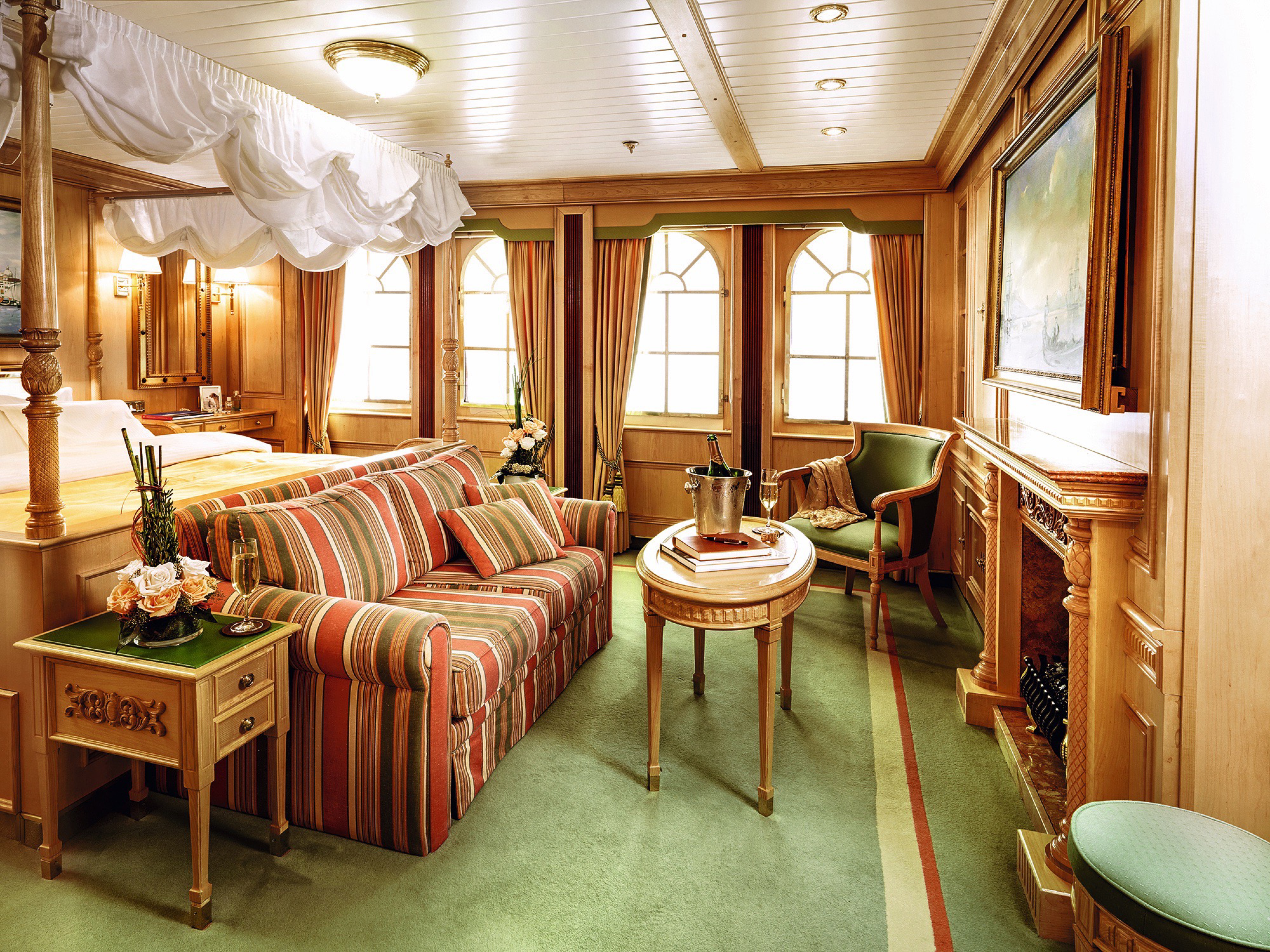
Luxury Owner Suites (Cat. A)
Our two owner suites follow the tradition in the maritime world of always having their own cabins ready for the ship owners. We have reserved these living areas for those of our guests who appreciate special comfort and cosiness even on board a tall ship. Both light-flooded suites are located on the lidodeck and with their large panoramic windows offer a unique view of the sea even from a four-poster bed. The spacious ambience includes selected individual pieces of furniture, four large cupboards, the fireplace – and last but not least the large bathroom with bathtub and separate shower, marble washstand including the legendary golden fittings.
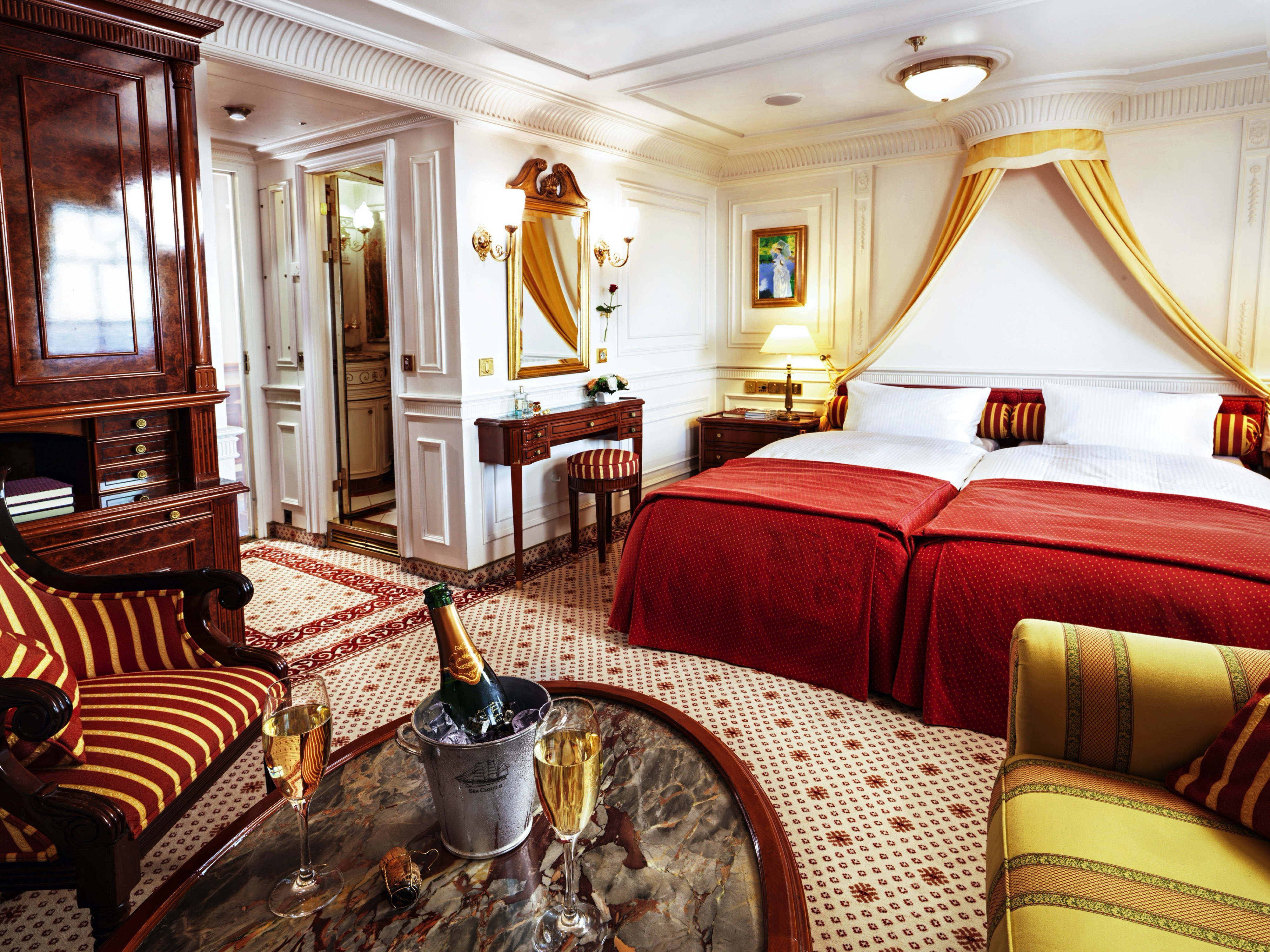
Junior Suites (Cat. B)
With their rosewood furniture, stucco elements on the walls and a decorative marble fireplace, the Junior Suites are the epitome of Hanseatic solidity. The simple elegance corresponds in gentle tension with the maritime atmosphere in front of the panorama windows, which offer a view of the vastness of the sea. A separate sitting area and a walk-in closet round off the comfortable ambience. Bathtub, marble washbasin and golden fittings are of course also standard in this category. The junior suites are located on the promenade deck, so that the restaurant, boutique and reception can easily be reached.
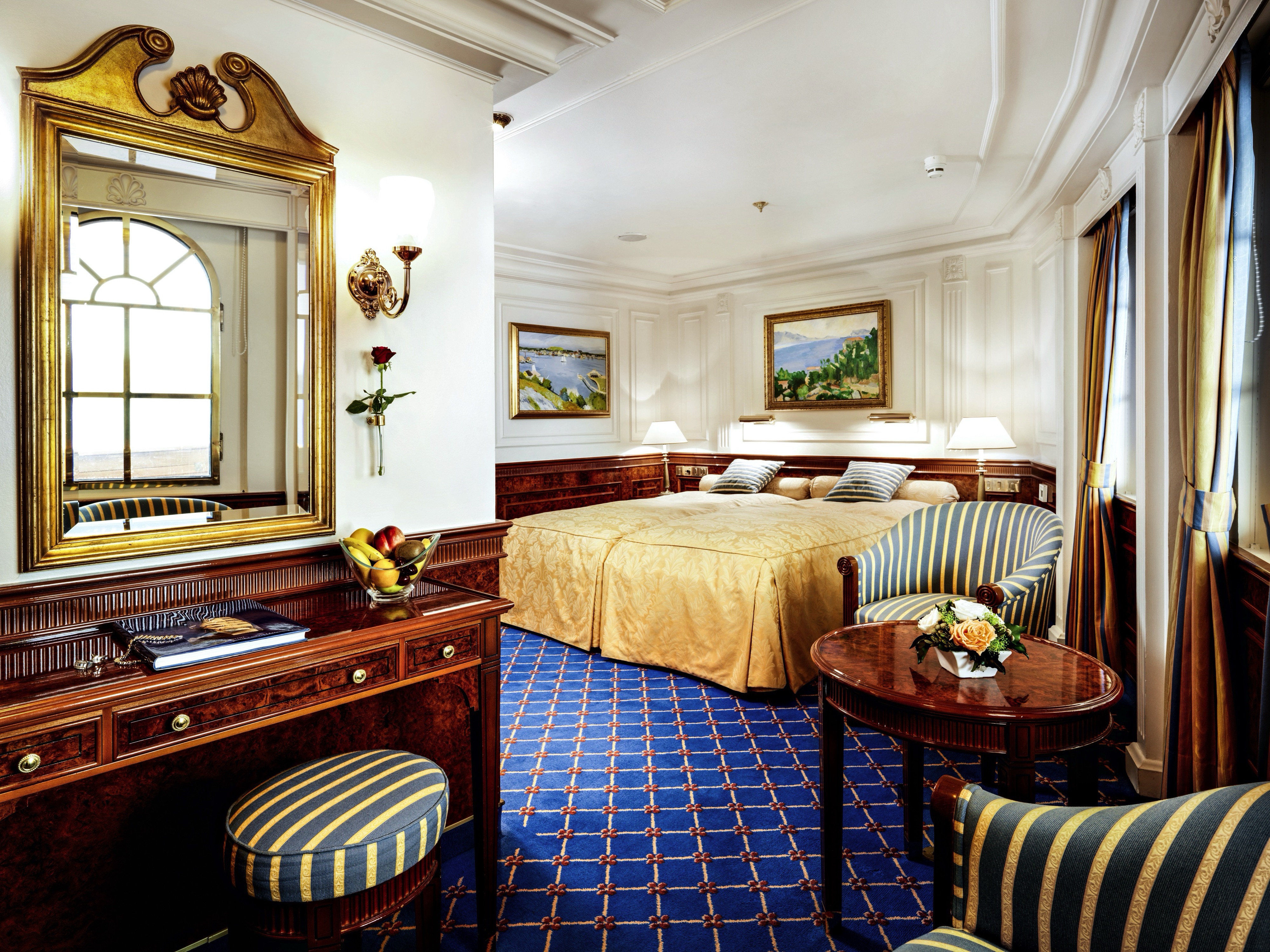
De Luxe Double-Bed Cabins (Cat. C)
This De-Luxe outside cabin combines the comfort and solidity that characterizes the suites with a special maritime cosiness. Thanks to its location in the front area of the promenade deck, the floor plan follows the elegant line of the SEA CLOUD II and thus additionally conveys the feeling of security on a luxury private yacht. The panorama windows offer a wonderful view of the sea.
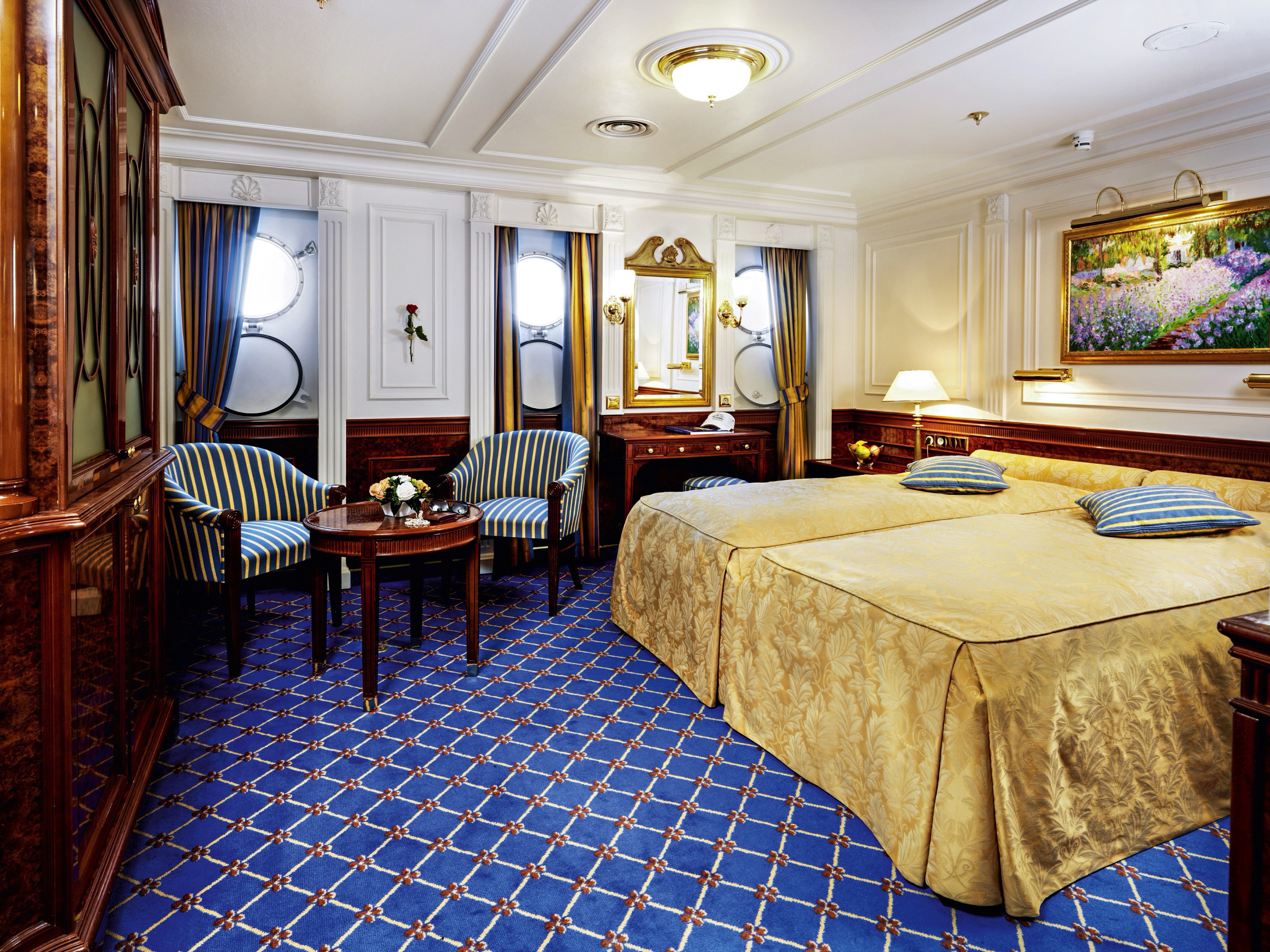
De Luxe Double-Bed Cabins (Cat. D)
The three large porthole windows give our De-Luxe Category D outside cabins a special maritime flair. Together with their luxurious yacht ambience, these cabins underline the feeling of being part of an extraordinary journey on an extraordinary ship. Stylish individual pieces of furniture and a beautiful seating area make the spacious room cosy. The six De-Luxe outside cabins are located amidships on the same deck where the massage and cosmetic treatments, the fitness room, the bathing platform and the hospital are located.
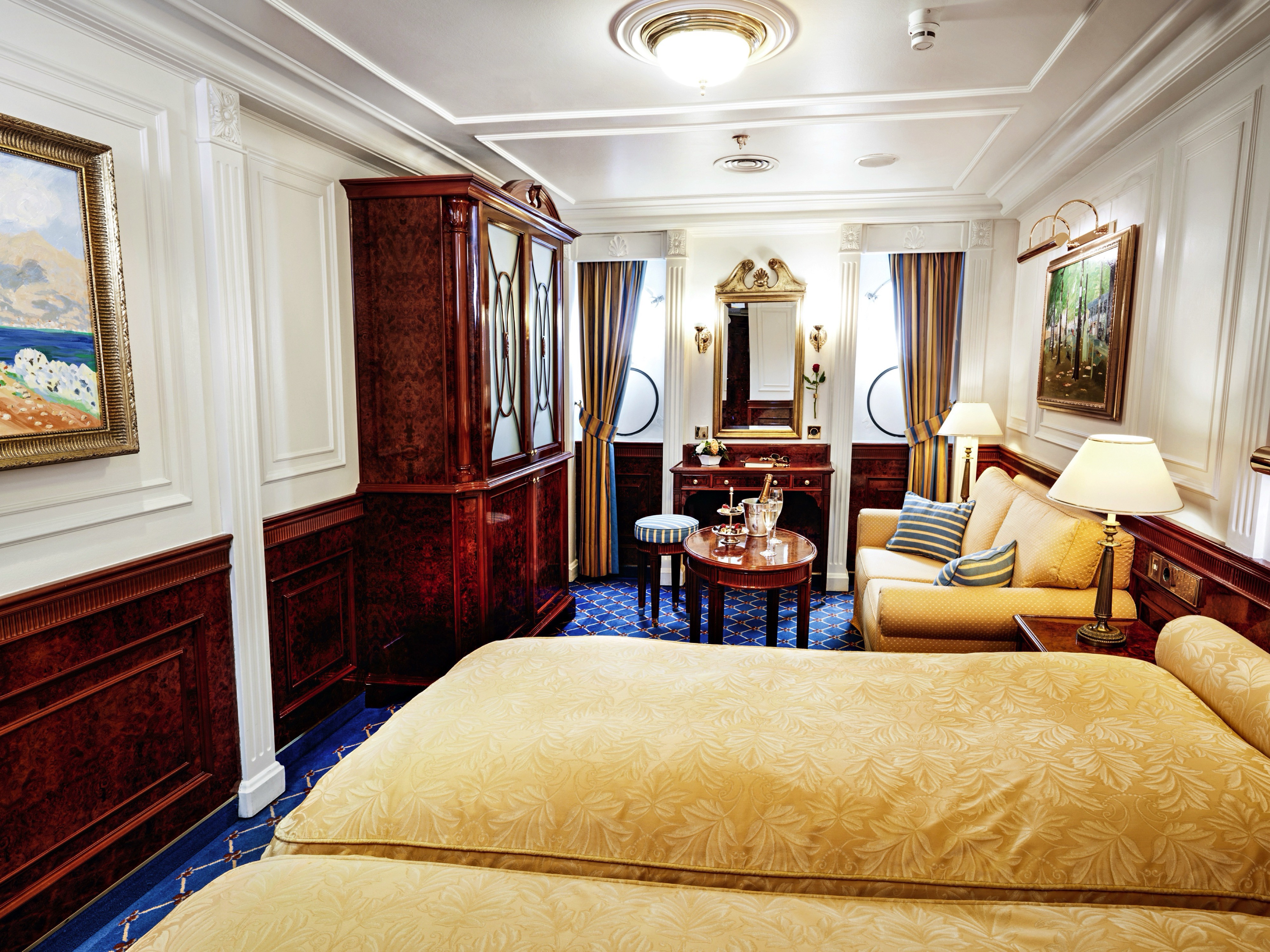
De Luxe Double-Bed Cabins (Cat. E)
These outside cabins on both sides of the cabin deck are the epitome of cosiness on board the SEA CLOUD II. This is where you can retreat, switch off and relax while enjoying the unique luxurious ambience for which our yachts are famous. Like the other cabins, Category E is equipped with TV/DVD, a mini-bar and a safe. An interesting detail: the double bed can be divided into two single beds on request.
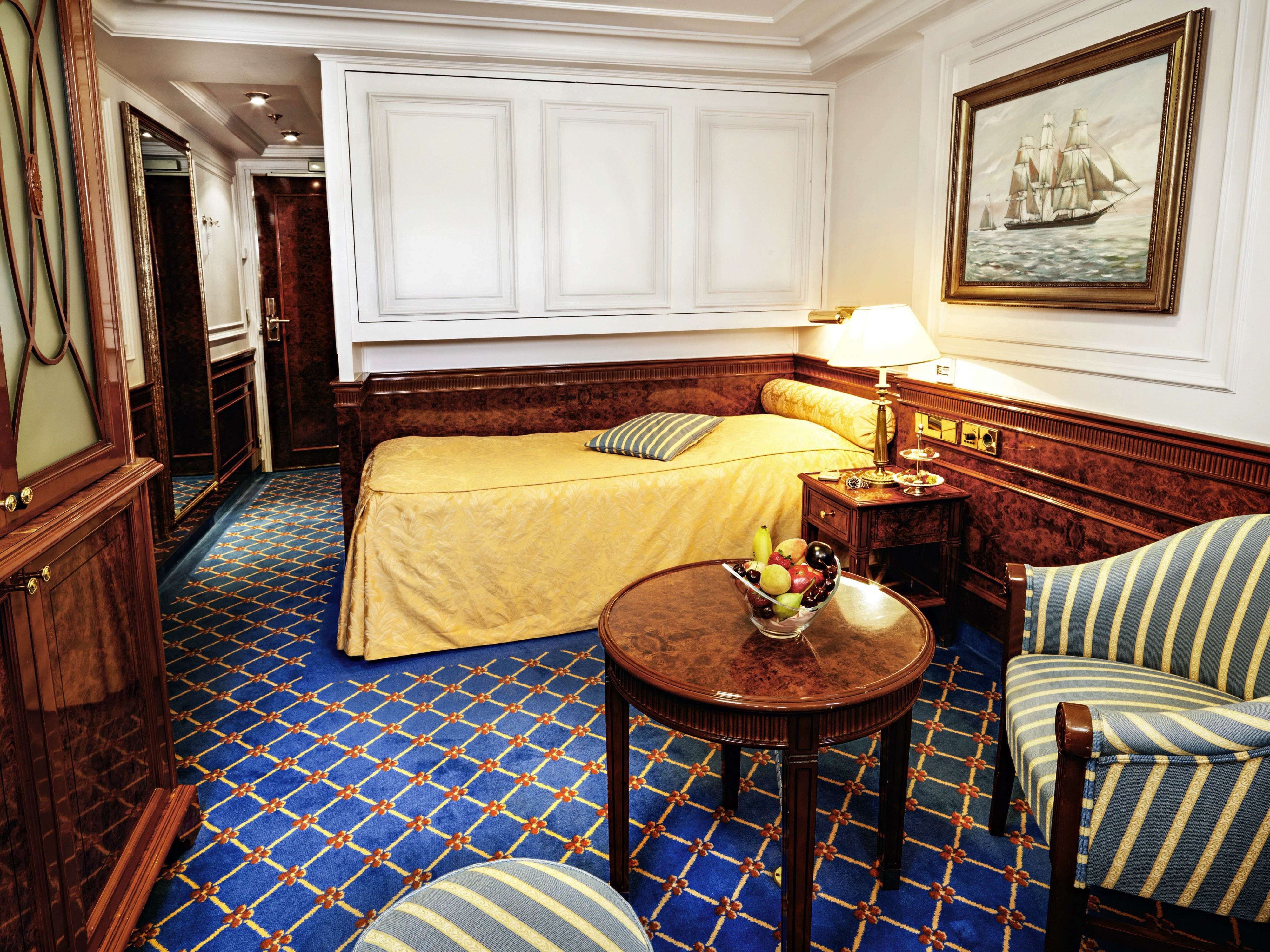
Upper-/Lower-Bed Cabins (Cat. F)
This outside cabin on the cabin deck is still modelled on the officers’ cabins as on traditional windjammers and is equipped with an upper and lower berth. Warm woods and a comfortable sitting area radiate a cosy, maritime atmosphere and offer you a cosy retreat. Our recommendation: this cabin is ideal for single travellers.
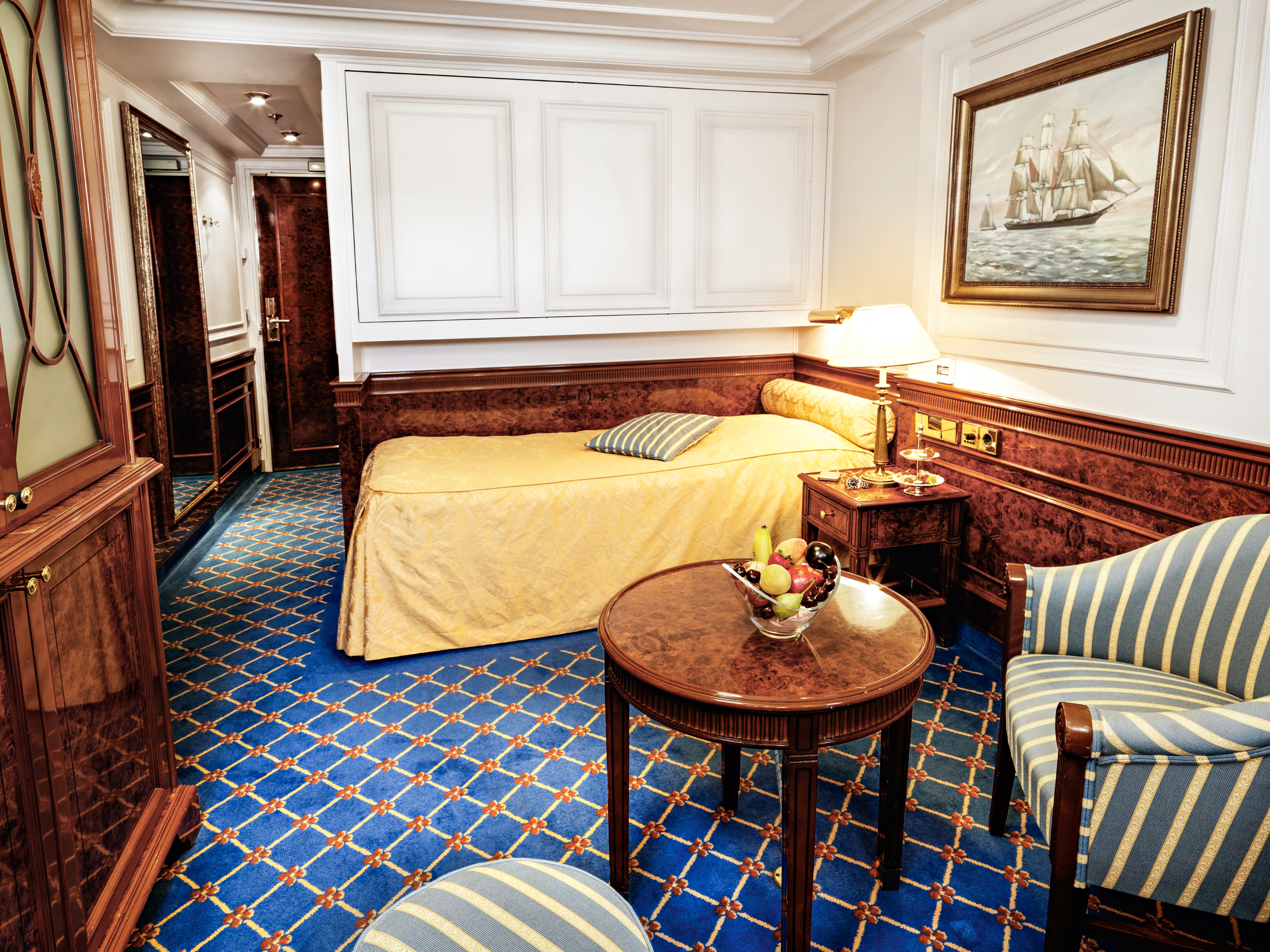
Guarantee Cabins
Guaranteed double cabins: The range of accommodation starts from Cat. F. You will receive your exact cabin number when arriving on board. The allotment for this category is very limited.
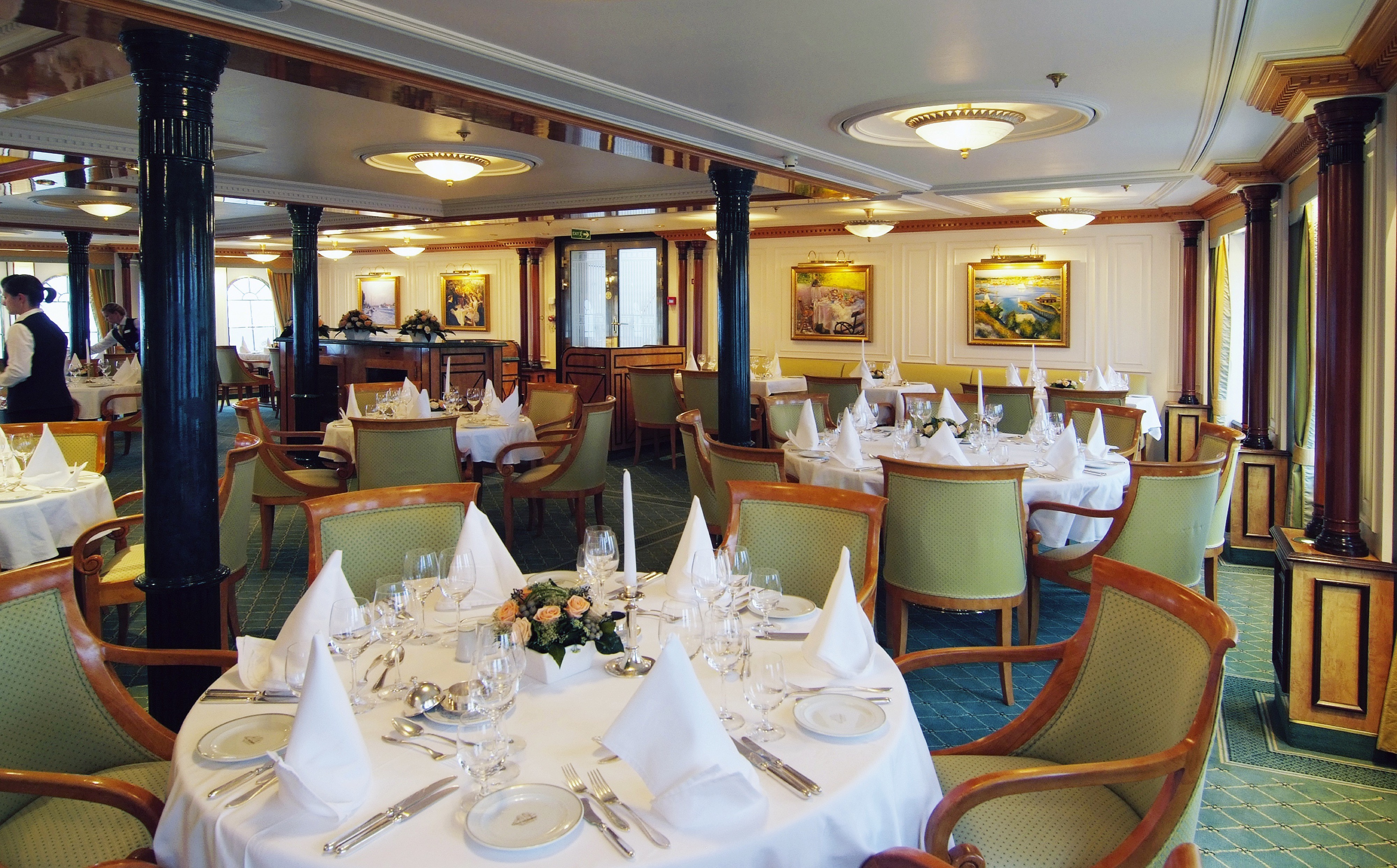
Restaurant
In the restaurant you will find tables for couples and groups of four, six and eight. The lido deck is often an inviting place to have lunch or an evening barbecue out in the open air. No matter whether you are sitting inside or outside, you can all enjoy this feast for the senses together in the same sitting. And since you are dining on a tall ship with the character of a private yacht, you are free to choose your place and company at the table. Our culinary creations are sure to impress even the most discerning of connoisseurs – it is easy to see why the SEA CLOUD II was chosen to join the exclusive Chaîne des Rôtisseurs group.
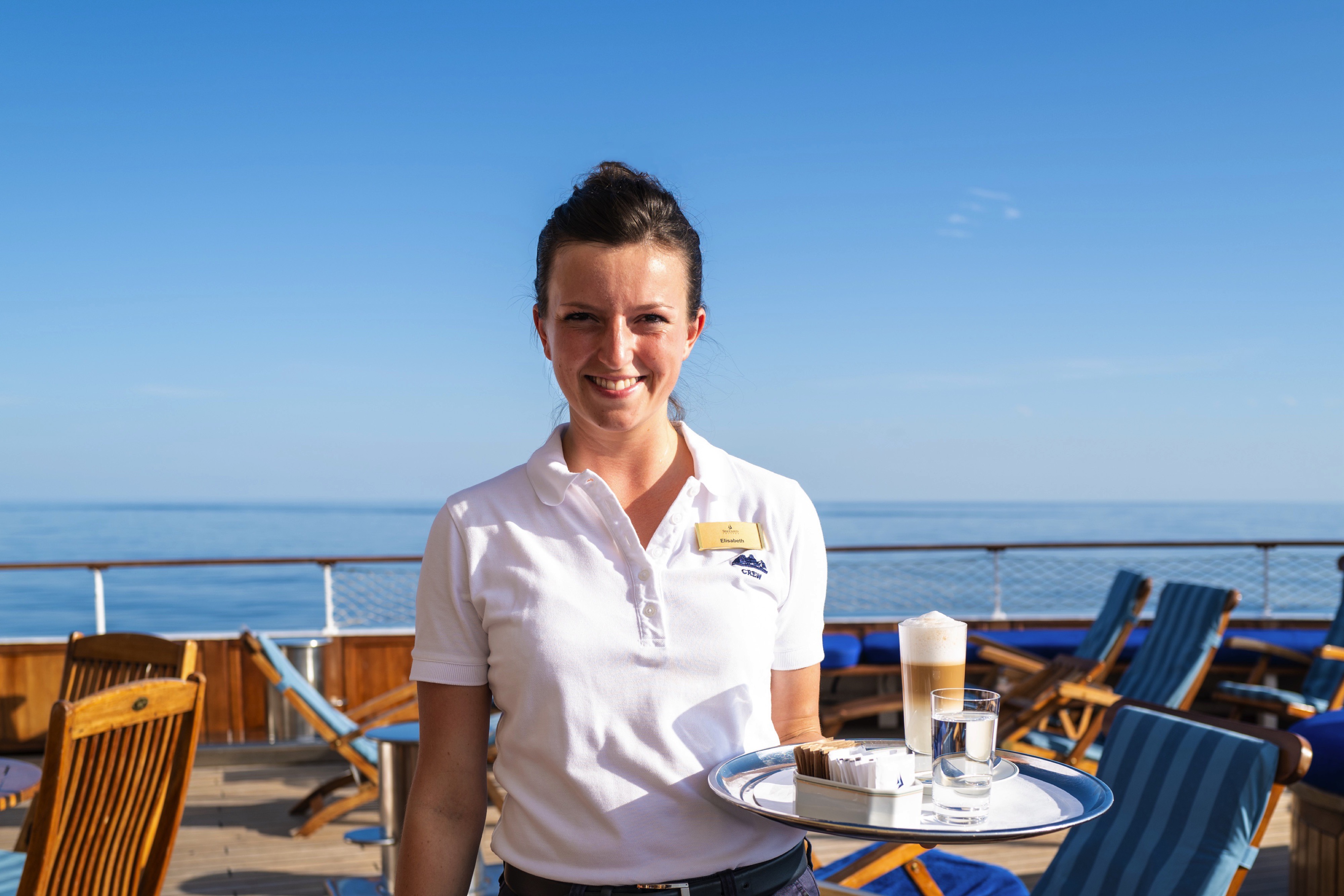
Lido Deck
You will find a dining area and Lido Bar on the Lido Deck.
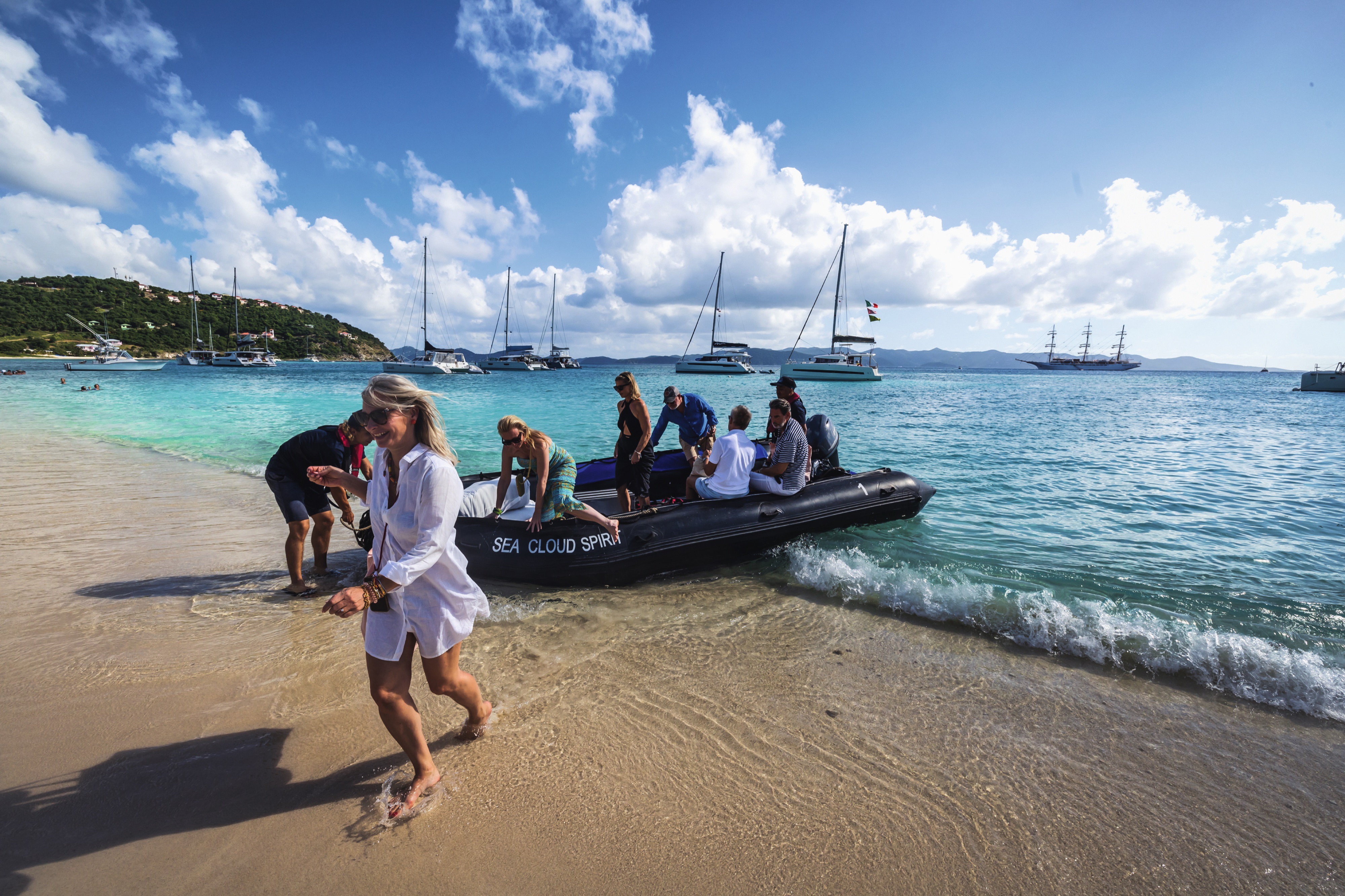
Zodiacs
Smaller ships, greater possibilities
Among the many joys of travelling smaller: a quick spin on a zodiac, enjoying the beach barbeques in secluded bays, photo safaris, pausing for a dip in the azure sea. And on selected tours, some exclusive experiences are included – a private concert, an opera house or a palace tour, a culinary visit to a special vineyard, or a front-row seat at a legendary regatta.
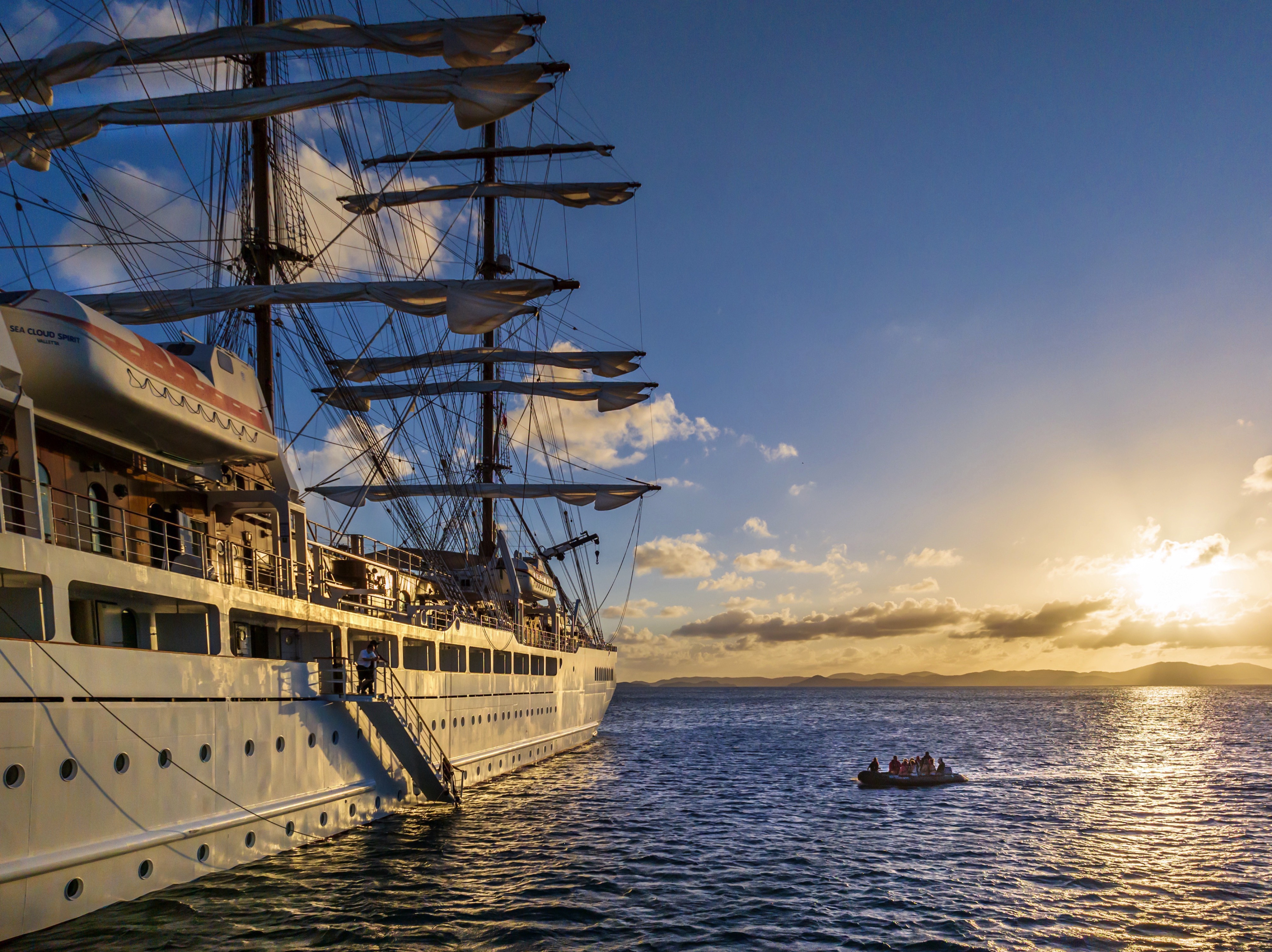
Watersports
Dive in and be active
Whether you want to start your swim directly from the ship or explore the colorful world on the reef – water sports are even more fun under the Caribbean sun. Equipment is available for everyone: Snorkels, fins and stand-up paddles are waiting for you. If you are in the mood for even greater action, let yourself be glided across the crystal clear waters by tubing in the Caribbean.
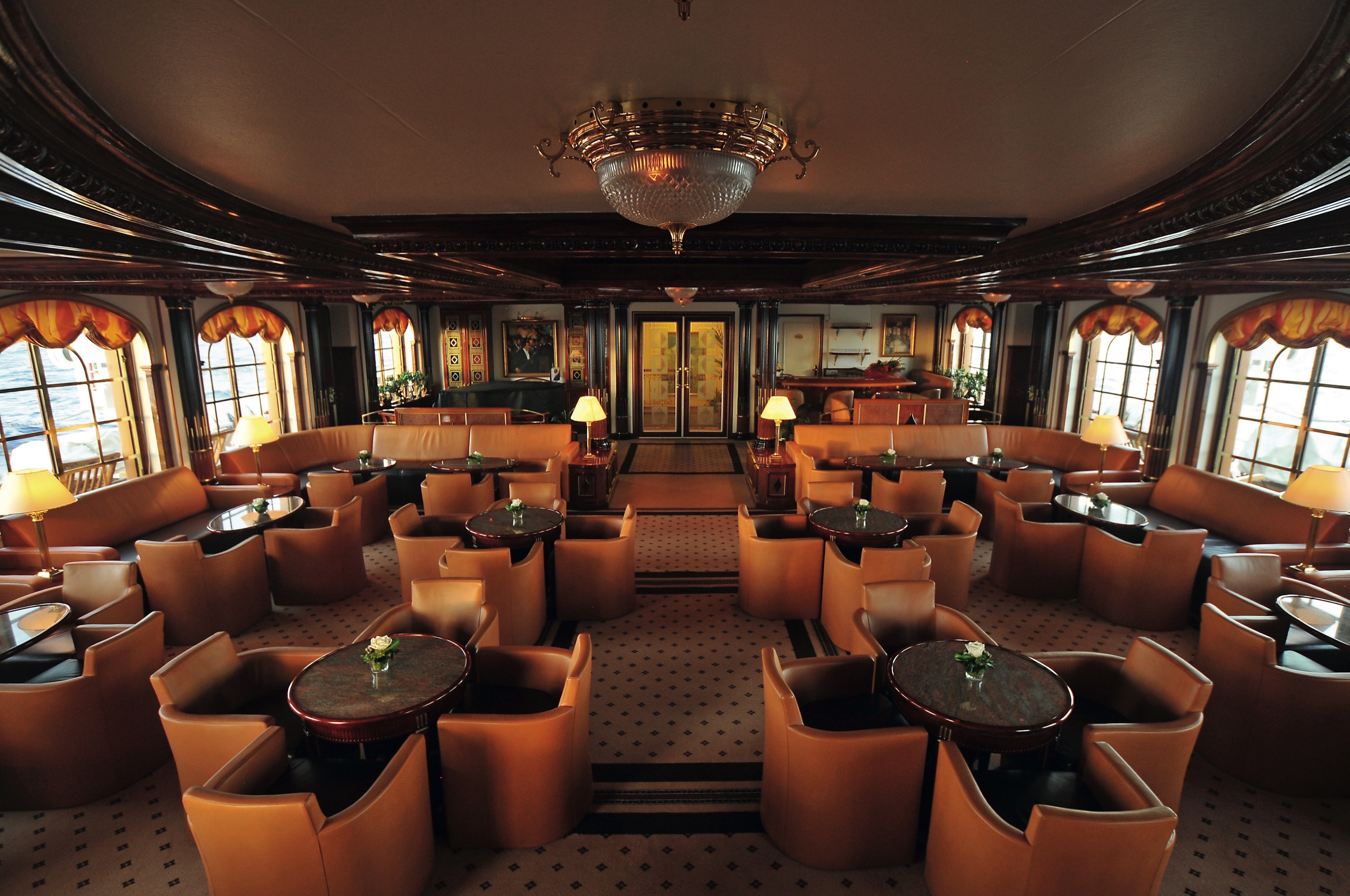
Lounge
In the middle of the lido deck you will find the spacious lounge. At certain times you will hear gentle music from the Steinway piano and, on selected cruises, you can listen to some interesting talks.
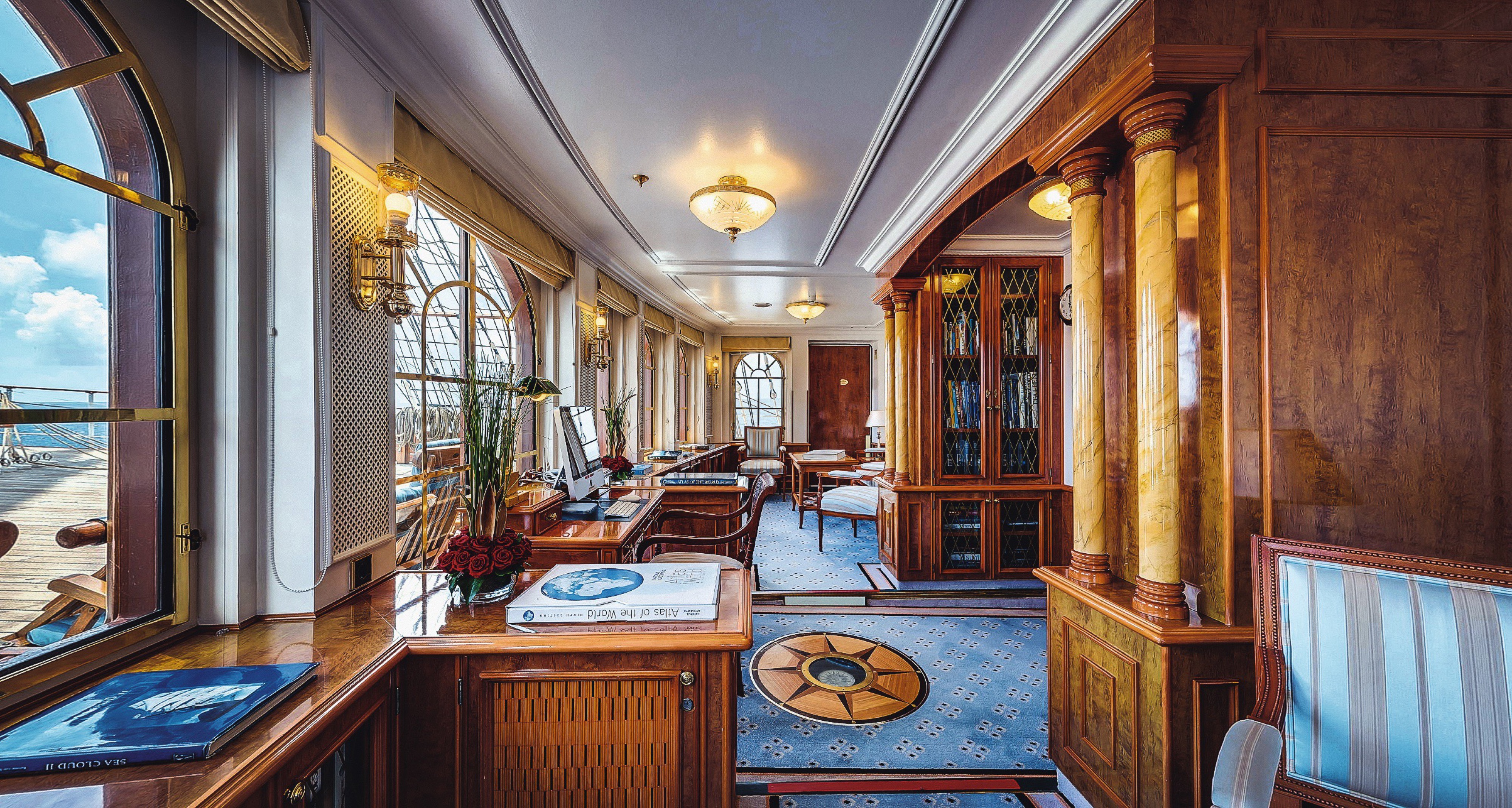
Library
Also on the Lido Deck, you will find the library on the lido deck which contains selected literature, DVDs, popular board games, the SEA CLOUD II’s intriguing guest book and a laptop with internet access. But this is not just a place to get engrossed in reading; you should also enjoy the breathtaking all-round view of the ship’s forecastle – do not forget that you are on board a majestic tall ship!
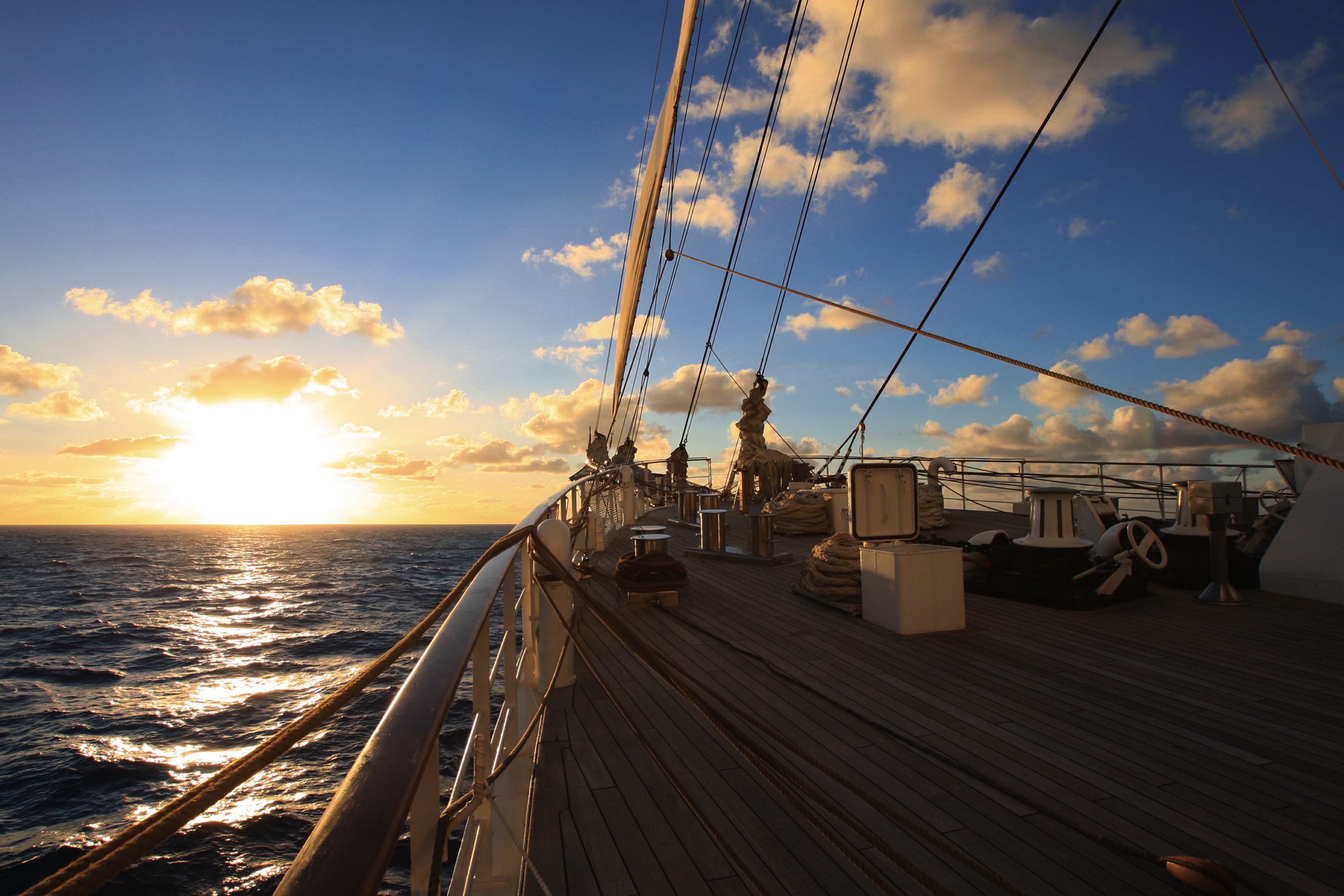
On Deck
To watch the movement of the sails and all the traditional tasks associated with a tall ship is for many people one of the most wonderful experiences on the high seas. On all the decks you will of course find many traditional deckchairs and benches on which you can sit alone or in a small group, gazing out to sea. On the sun deck you will also find two large sun loungers and the bridge. The officers will be happy to welcome you into the command centre – manoeuvres permitting.
Our snorkelling equipment can be taken ashore at any time. The on-board zodiac boats do not only take you ashore and back to the SEA CLOUD II, but are also used to tow the “Fun Island”, our inflatable water sled for those who fancy some high-speed fun! Depending on sea conditions, the swim platform provides direct access to the largest swimming pool in the world: the sea. And in the evening, the lido deck is a wonderful place to wind down with a nice drink. You might also be entertained by our Crew Shanty Choir.
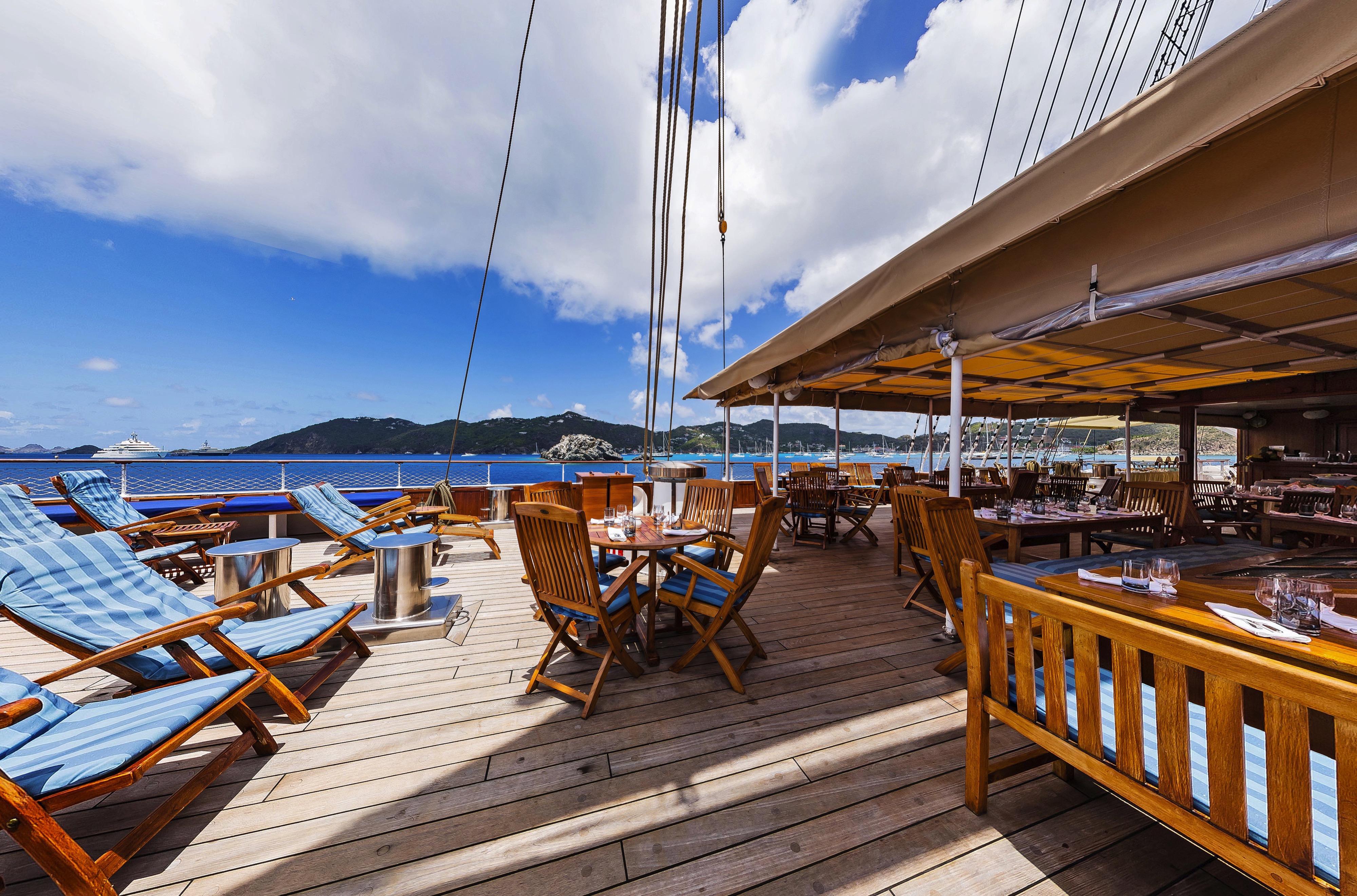
Lido Deck with Bar
The Lido bar is open daily from 11:00 am. Soft drinks, coffee, tea, water and juices are available all day free of charge.
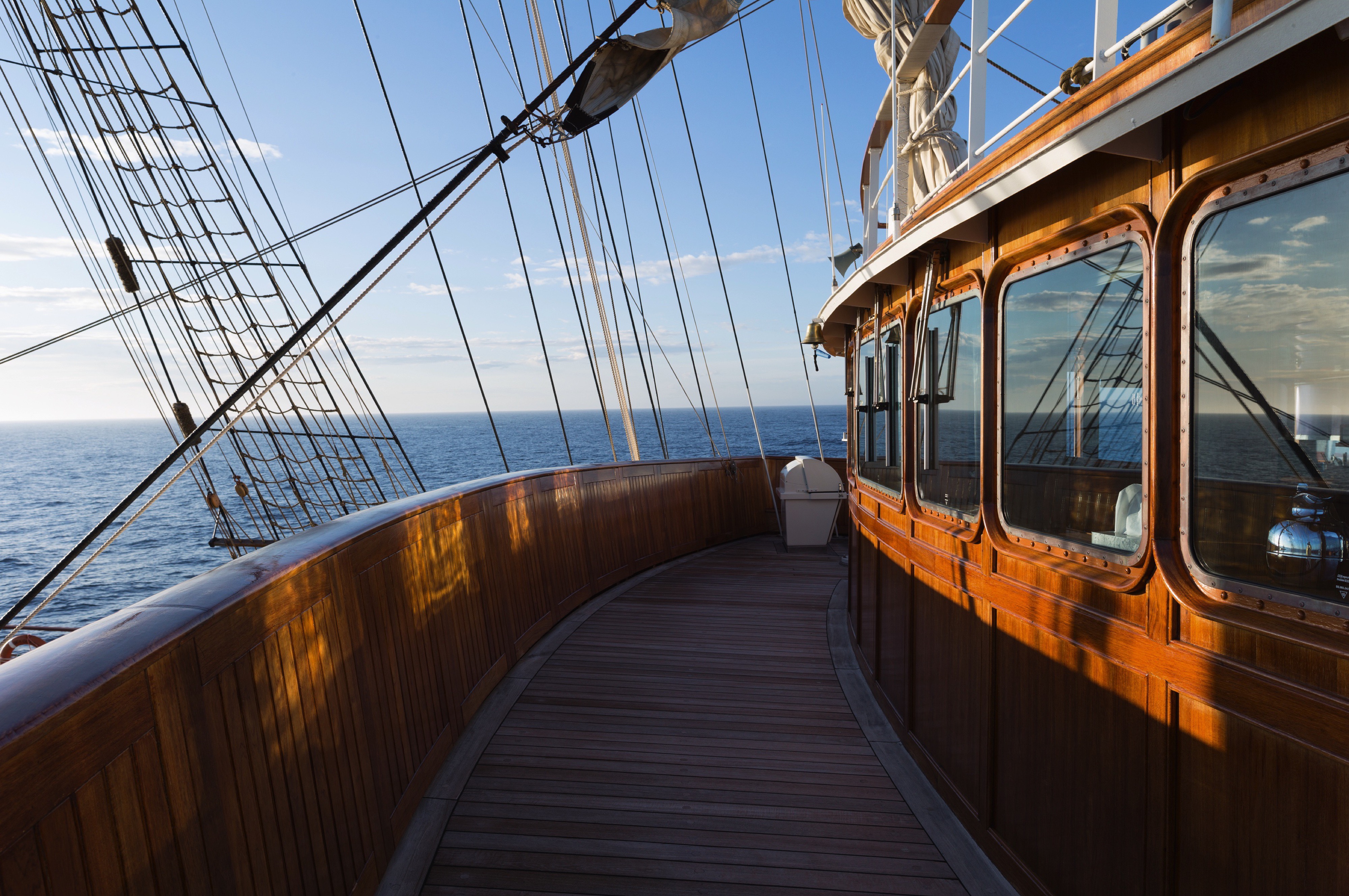
Bridge
The Bridge can be located on the Sun Deck.
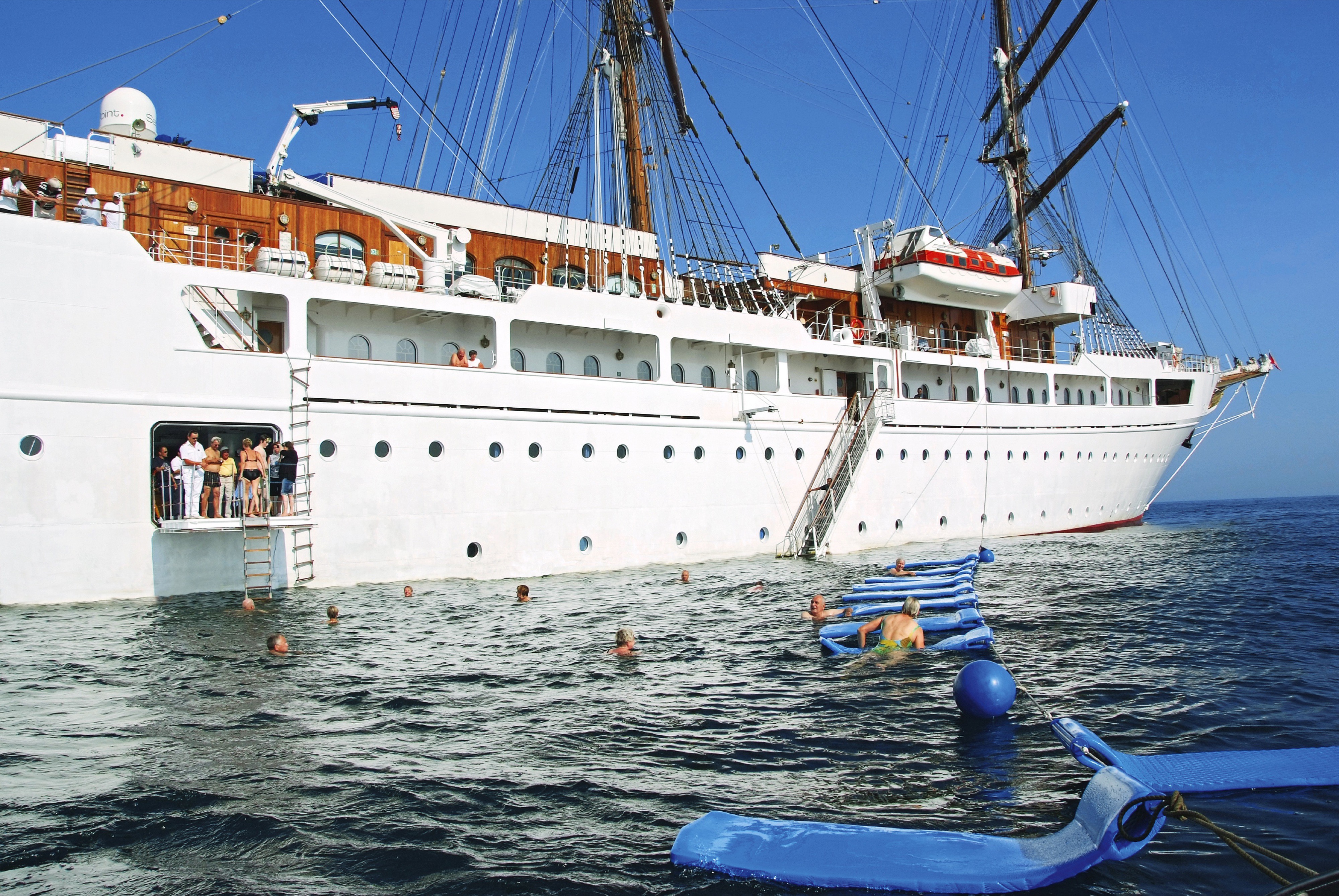
Swim Platform
The Swim Platform is located on the cabin deck.
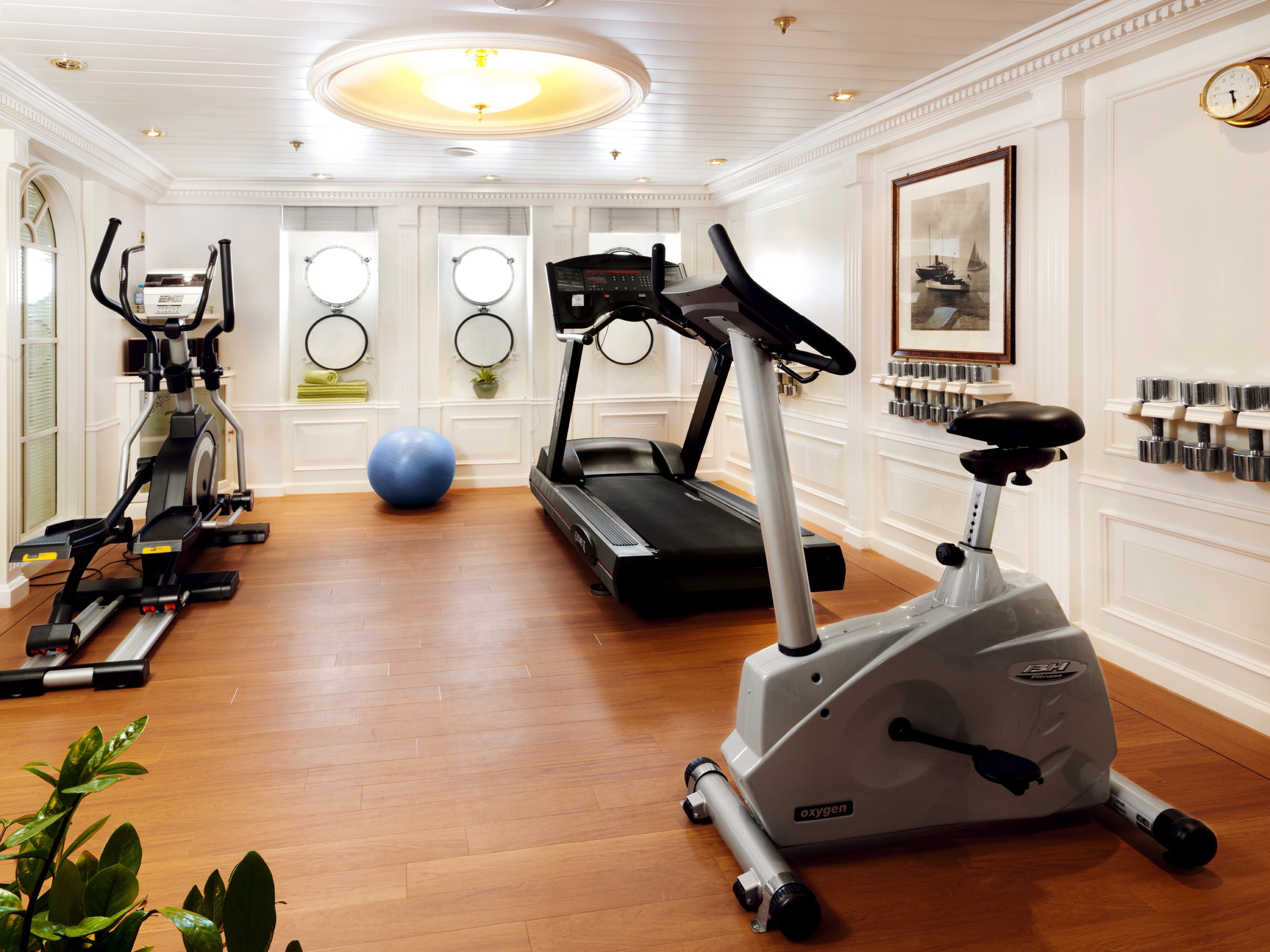
Fitness and Sport
Fitness enthusiasts can use the 100-metre long lido deck as their running/walking circuit while taking in all the different views which you can expect on board a tall ship. For others, our morning exercise sessions are just the way to start a new day. In the smart fitness studio, you will find dumbbells, bikes, treadmills and step machines for more focused workouts, and the adjoining sauna area will enhance your general well-being.
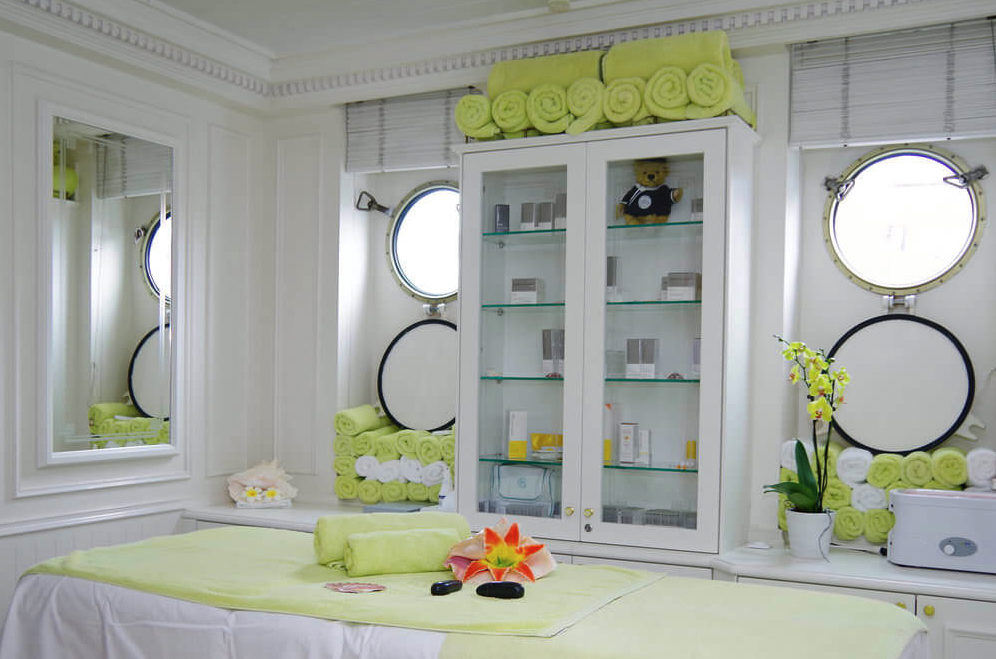
Massage & Cosmetics
We provide a range of spa services on board the SEA CLOUD II (massages and beauty treatments at additional cost), using the finest products from Maria Galland.
Special Dietary Requirements
The chef will happily accommodate special diet requests—please let us know about any requests in advance so that we may prepare.
Dress Code
During the day, and depending on the weather, a sophisticated summer look is suitable. For the evening, we recommend smart-casual wear. We also kindly request that guests refrain from wearing shorts at evening meals. The Captain’s Dinner (an event which normally takes place twice on each trip – once on short cruises) is a time when our guests tend to opt for a more elegant look. We recommend a suit for men and appropriate smart dress for women. Please remember to take some non-slip shoes with you.
Disabled Access
Our tall ships SEA CLOUD and SEA CLOUD II are not accessible for all people with disabilities and are not suitable for wheelchair users. Please contact our cruise consultancy for further details.
Smoking Policy
Smoking is permitted only on the outer decks outside of meal times. We kindly request that smokers take the comfort of other passengers into consideration. Smoking is prohibited on the blue lagoon deck and covered areas of the spanker and lido deck at all times.
Wi-Fi
Our yachts are equipped with Starlink. WIFI is available in the public areas on all ships and in your cabin on SEA CLOUD SPIRIT. You can use your own laptop, tablet, or smartphone to connect to the internet with the access code (WIFI) for a fee. WIFI packages can be purchased at the reception. Please note that WIFI service on board is not comparable to on land and might be interrupted at times due to lack of coverage in certain areas.
Laundry Services
Laundry services available on board are limited to washing and ironing. There is no dry-cleaning available. The washing and ironing service is provided at an additional charge and is carried out overnight. For guests with bookings in Cat. A-C (SEA CLOUD) or Cat. A+B (SEA CLOUD II), this service is free of charge. For safety reasons, passengers are not permitted to iron in their cabins.
Children on Board
Children are of course very welcome on our ships, however there is no supervision or entertainment available for children.
Sustainability & Low Impact Tourism
We approach the people and their cultures with respect in all the regions we visit, travelling mindfully through the local environment. By doing this, we can bring our guests closer – in the truest sense of the word – to these places, and what makes each one special.
THE WINDJAMMER EXPERIENCE
For you and us alike, the key attraction of our trips is the chance to sail on the open seas.
We therefore take every opportunity to set sail and be propelled by the sheer power of the wind. That is why the captain will sometimes change the route if the weather requires it. On board our SEA CLOUD tall ships, you’ll experience the elements, as many of the day-to-day activities take place outside.
HAVING AS LITTLE IMPACT AS POSSIBLE
When we do have to start the engines, we utilise low-sulphur marine diesel on all three of our windjammers.
For us, this is standard practice. Even the SEA CLOUD, our very first windjammer, was equipped with this technology right from the start. Our motto: to minimise our impact on the environment yet still make a profound and positive impression on those around us.
A SUSTAINABLE APPROACH TO LIFE ON-BOARD
Avoiding plastic, reducing water usage and protecting the environment.
These are the factors that guide us in the day to day operation of our ships and our ongoing development of eco-friendly alternatives. To cite just one example, our reusable drinks bottles are not only easy on the eye, but also easy on the environment.
QUALITY, NOT QUANTITY
Our ‘small but perfectly formed’ windjammers are able to visit smaller ports, away from the busy routes frequented by large cruise liners.
With a maximum of 64 to 136 passengers, we’re always welcomed in those locations thanks to our approach of visiting local communities rather than overwhelming them. Needless to say, our itineraries also include some classic destinations, though we usually visit these only when the mega-liners have moved on.
BOOSTING THE LOCAL ECONOMY
Procuring supplies locally, working with local, smaller-scale agencies and paying fair prices.
By taking this approach, we see ourselves as a partner for our local service providers, with whom we’ve built relationships based on trust over many years. After all, we want our voyages to benefit both our guests and the communities we visit around the world.
AUTHENTIC CUISINE
Our menus are always a true reflection of the regional cuisine.
This is because our chefs enjoy buying exotic spices, local specialities and freshly caught fish from local markets to bring you – even in a culinary sense – closer to the places we visit.
A MEMBER OF THE FUTOURIS NETWORK
Heading into the future with Futouris.
Preserving the natural and cultural heritage of our world and shaping the future of tourism in a sustainable way is what Futouris stands for. Members of the network are working globally to improve people’s living conditions, preserve biodiversity and protect the environment and climate.
Medical Facilities
All three ships have a hospital, which is supervised by a ship’s doctor. Medical consultation hours can be found in the daily program. In case of an emergency, the doctor can be reached at any time by calling 911.
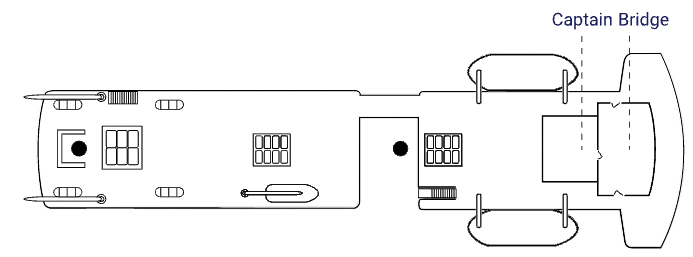
Sun Deck
- Captain
- Bridge

Lido Deck
- Lounge
- Lido Bar
- Lido Deck
- Library
- Luxury Owner Suites

Promenade Deck
- Restaurant
- Boutique
- Purser
- Reception
- Junior Suites
- De luxe double-bed cabins

Cabin Deck
- Fitness Area
- Massage and Cosmetics
- Hospital
- Swim Platform
- De luxe double-bed cabins
- Upper/Lower-bed Cabins
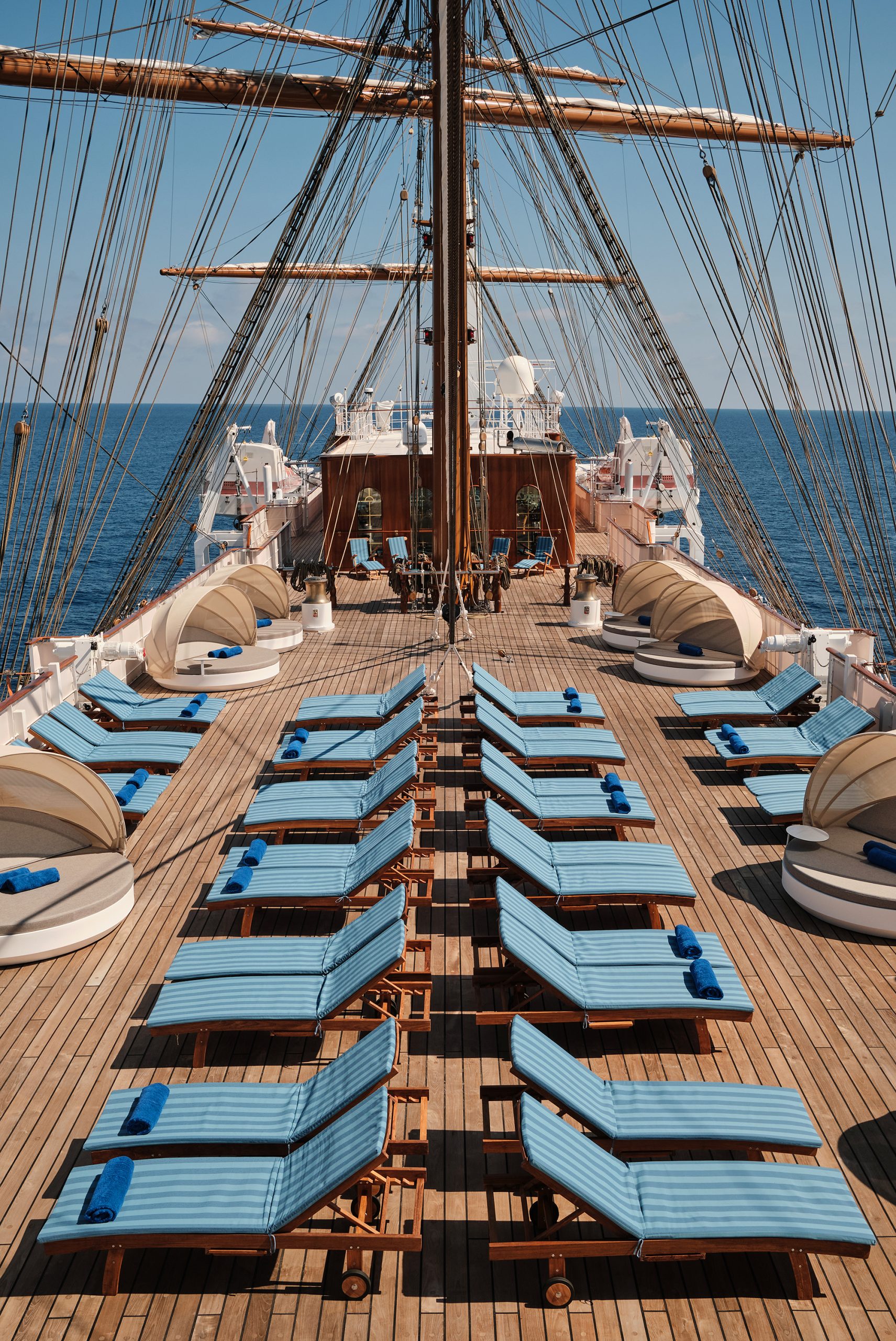
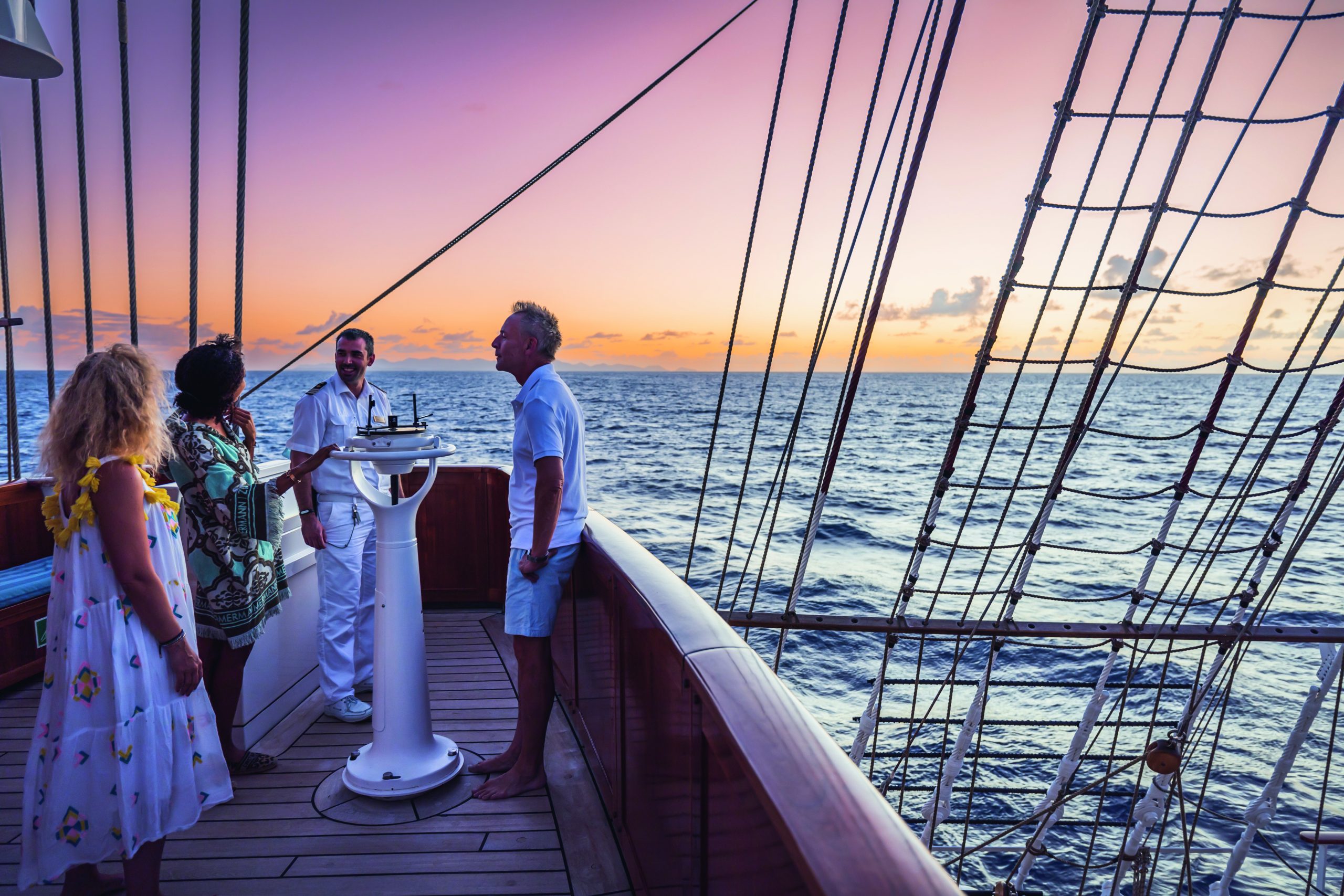
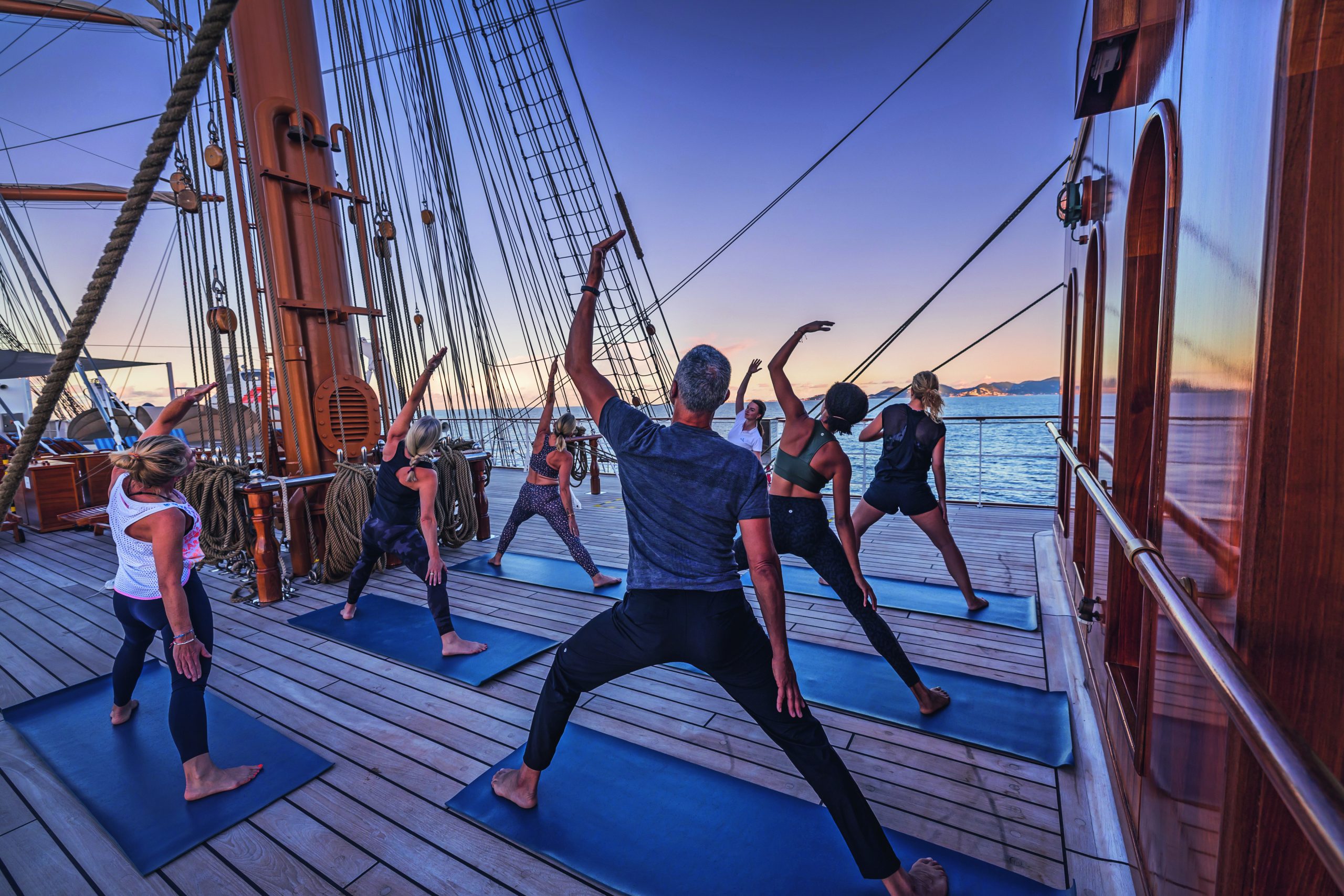
Itinerary
Livorno is a gritty city with a long and interesting history. In the early Middle Ages it alternately belonged to Pisa and Genoa. In 1421 Florence, seeking access to the sea, bought it. Cosimo I (1519–74) started construction of the harbor in 1571, putting Livorno on the map. After Ferdinando I de’ Medici (1549–1609) proclaimed Livorno a free city, it became a haven for people suffering from religious persecution; Roman Catholics from England and Jews and Moors from Spain and Portugal, among others, settled here. The Quattro Mori (Four Moors), also known as the Monument to Ferdinando I, commemorates this. (The statue of Ferdinando I dates from 1595, the bronze Moors by Pietro Tacca from the 1620s.)In the following centuries, and particularly in the 18th, Livorno boomed as a port. In the 19th century the town drew a host of famous Britons passing through on their grand tours. Its prominence continued up to World War II, when it was heavily bombed. Much of the town’s architecture, therefore, postdates the war, and it’s somewhat difficult to imagine what it might have looked like before. Livorno has recovered from the war, however, as it’s become a huge point of departure for container ships, as well as the only spot in Tuscany for cruise ships to dock for the day.Most of Livorno’s artistic treasures date from the 17th century and aren’t all that interesting unless you dote on obscure baroque artists. Livorno’s most famous native artist, Amedeo Modigliani (1884–1920), was of much more recent vintage. Sadly, there’s no notable work by him in his hometown.There may not be much in the way of art, but it’s still worth strolling around the city. The Mercato Nuovo, which has been around since 1894, sells all sorts of fruits, vegetables, grains, meat, and fish. Outdoor markets nearby are also chock-full of local color. The presence of Camp Darby, an American military base just outside town, accounts for the availability of many American products.If you have time, Livorno is worth a stop for lunch or dinner at the very least.
Located in the South of Corsica, Bonifacio is one of the island’s most beautiful destinations. From its breathtaking views and sandy white islands to its historic citadel, the city is a must visit for anyone travelling to the island.
Considered Corsica’s primary commercial and cultural hub, the largest city and regional capital of Ajaccio is situated on the west coast of the island, approximately 644 km (400 miles) southeast of Marseille, France. Founded in 1492, vestiges of ancient Corsica in this ville impériale revolve around the city’s most famous son, Napoléon Bonaparte, whose family home—now the national museum Maison Bonaparte—pays tribute to the emperor’s historical influence.Remnants from what was originally a 12th-century Genoese colony are still visible around the Old Town near the imposing citadel and watchtower. Perfect for exploring, the luminous seaside city surrounded by snowcapped mountains and pretty beaches offers numerous sites, eateries, side streets, and a popular harbor, where sailboats and fishing vessels moor in the picturesque Tino Rossi port lined with well-established restaurants and cafés serving fresh local fare.
“Where the mountains meet the sea,” the beautiful island of Corsica, set in the blue waters of the Mediterranean between Italy and France, is steeped in history. Ile Rousse is built on the site of an old roman settlement. She rivals Calvi as a seaside resort, with nice sandy beaches and good accommodation facilities. The port of Ile Rousse was built by Pasquale Paoli –most famous Corsican Patriot-in 1758 to replace Calvi, still in Genoese hands, has taken the place of first port in this region for exporting fresh fruit and olive oil. The harbour is located on an peninsula, red coloured rock, that just comes out of the sea hence the name of Ile Rousse which means “ reddish island”. There is a lighthouse at the outer end of the island with an old ruined tower. Returning to the mainland a street leads from port to town centre along a nice sandy beach, towards the main square Place Paoli. In the middle of the square there is a statue of Pascal Paoli. During Summer season, the square surrounded by palm trees welcomes numerous tourists looking for some shade and refreshing ice cream. The old market situated in the middle of the town, faced to the Paoli square, offers a large choice of fresh fruits and veggies as well as fish from the catch of the day, or a sample of the famous Corsican delicatessen, cheeses, honeys and wines.
Elba is the Tuscan archipelago’s largest island, but it resembles nearby verdant Corsica more than it does its rocky Italian sisters, thanks to a network of underground springs that keep it lush and green. It’s this combination of semitropical vegetation and dramatic mountain scenery—unusual in the Mediterranean—that has made Elba so prized for so long, and the island’s uniqueness continues to draw boatloads of visitors throughout the warm months. A car is very useful for getting around the island, but public buses stop at most towns several times a day; the tourist office has timetables.
One of the most photographed villages along the coast, with a decidedly romantic and affluent aura, Portofino has long been a popular destination for the rich and famous. Once an ancient Roman colony and taken by the Republic of Genoa in 1229, it’s also been ruled by the French, English, Spanish, and Austrians, as well as by marauding bands of 16th-century pirates. Elite British tourists first flocked to the lush harbor in the mid-1800s. Some of Europe’s wealthiest drop anchor in Portofino in summer, but they stay out of sight by day, appearing in the evening after buses and boats have carried off the day-trippers.There’s not actually much to do in Portofino other than stroll around the wee harbor, see the castle, walk to Punta del Capo, browse at the pricey boutiques, and sip a coffee while people-watching. However, weaving through picture-perfect cliffside gardens and gazing at yachts framed by the sapphire Ligurian Sea and the cliffs of Santa Margherita can make for quite a relaxing afternoon. There are also several tame, photo-friendly hikes into the hills to nearby villages.Unless you’re traveling on a deluxe budget, you may want to stay in Camogli or Santa Margherita Ligure rather than at one of Portofino’s few very expensive hotels. Restaurants and cafés are good but also pricey (don’t expect to have a beer here for much under €10).
On one of the best stretches of the Mediterranean, this classic luxury destination is one of the most sought-after addresses in the world. With all the high-rise towers you have to look hard to find the Belle Époque grace of yesteryear. But if you head to the town’s great 1864 landmark Hôtel de Paris—still a veritable crossroads of the buffed and befurred Euro-gentry—or enjoy a grand bouffe at its famous Louis XV restaurant, or attend the opera, or visit the ballrooms of the casino, you may still be able to conjure up Monaco’s elegant past. Prince Albert II, a political science graduate from Amherst College, traces his ancestry to Otto Canella, who was born in 1070. The Grimaldi dynasty began with Otto’s great-great-great-grandson, Francesco Grimaldi, also known as Frank the Rogue. Expelled from Genoa, Frank and his cronies disguised themselves as monks and in 1297 seized the fortified medieval town known today as Le Rocher (the Rock). Except for a short break under Napoléon, the Grimaldis have been here ever since, which makes them the oldest reigning family in Europe. In the 1850s a Grimaldi named Charles III made a decision that turned the Rock into a giant blue chip. Needing revenue but not wanting to impose additional taxes on his subjects, he contracted with a company to open a gambling facility. The first spin of the roulette wheel was on December 14, 1856. There was no easy way to reach Monaco then—no carriage roads or railroads—so no one came. Between March 15 and March 20, 1857, one person entered the casino—and won two francs. In 1868, however, the railroad reached Monaco, and it was filled with Englishmen who came to escape the London fog. The effects were immediate. Profits were so great that Charles eventually abolished all direct taxes. Almost overnight, a threadbare principality became an elegant watering hole for European society. Dukes (and their mistresses) and duchesses (and their gigolos) danced and dined their way through a world of spinning roulette wheels and bubbling champagne—preening themselves for nights at the opera, where such artists as Vaslav Nijinsky, Sarah Bernhardt, and Enrico Caruso came to perform. Along with the tax system, its sensational position on a broad, steep peninsula that bulges into the Mediterranean—its harbor sparkling with luxury cruisers, its posh mansions angling awnings toward the nearly perpetual sun—continues to draw the rich and famous. One of the latest French celebrities to declare himself “Monégasque,” thus giving up his French passport, is superchef Alain Ducasse, who said that he made the choice out of affection for Monaco rather than tax reasons. Pleasure boats vie with luxury cruisers in their brash beauty and Titanic scale, and teams of handsome young men—themselves dyed blond and tanned to match—scour and polish every gleaming surface. As you might expect, all this glitz doesn’t come cheap. Eating is expensive, and even the most modest hotels cost more here than in nearby Nice or Menton. As for taxis, they don’t even have meters so you are completely at the driver’s mercy (with prices skyrocketing during events such as the Grand Prix). For the frugal, Monaco is the ultimate day-trip, although parking is as coveted as a room with a view. At the very least you can afford a coffee at Starbucks. The harbor district, known as La Condamine, connects the new quarter, officially known as Monte Carlo with Monaco-Ville (or Le Rocher), a medieval town on the Rock, topped by the palace, the cathedral, and the Oceanography Museum. Have no fear that you’ll need to climb countless steps to get to Monaco-Ville, as there are plenty of elevators and escalators climbing the steep cliffs. But shuttling between the lovely casino grounds of Monte Carlo and Old Monaco, separated by a vast port, is a daunting proposition for ordinary mortals without wings, so hop on the No. 1 bus from Saint Roman, or No. 2 from the Jardin Exotique – Both stop at Place du Casino and come up to Monaco Ville.
United with France only since 1860, Nice has its own history and atmosphere, which dates back 230,000 years. It was on Colline du Château (now château-less) and at the Plage des Ponchettes, in front of the Old Town, that the Greeks established a market-port in 350 BC and named it Nikaia, which would become Marseilles’ chief coastal rival. The Romans established themselves a little later on the hills of Cimiez (Cemenelum), already previously occupied by Ligurians and Celts, and quickly overshadowed the waterfront port. After falling to the Saracen invasions, Nice regained power as an independent state, becoming an important port in the early Middle Ages.So cocksure did it become that in 1388, Nice, along with the hill towns behind, effectively seceded from the county of Provence, under Louis d’Anjou, and allied itself with Savoie. Thus began its liaison with the House of Savoy, and through it with Piedmont and Sardinia, it was the Comté de Nice (Nice County). This relationship lasted some 500 years, tinting the culture, architecture, and dialect in rich Italian hues.By the 19th century Nice was flourishing commercially, locked in rivalry with the neighboring shipping port of Genoa. Another source of income: the dawning of tourism, as first the English, then the Russian nobility, discovered its extraordinary climate and superb waterfront position. A parade of fine stone mansions and hotels closed into a nearly solid wall of masonry, separated from the smooth-round rocks of the beach by what was originally named Camin deis Anglés (the English Way), which of course is now the famous Promenade des Anglais. This magnificent crescent, which is seeking UNESCO recognition, is one of the noblest in France. Many of Nice’s most delightful attractions—the Cours Saleya market, the Old Town streets, the Hotel Negresco, and the Palais Masséna—are on or close to this 10-km (6-mile) waterfront, making it the first stop for most visitors, while the redevelopment of Nice’s port, around the other side of the Colline du Château, makes it easier for amblers who want to take in the Genoese architecture or peruse the antiques at the Puces de Nice, now part of the Promenade des 100 Antiquaires, along Quai Papacino. Nice also has the distinction of the “Family Plus” label, with free strollers, play areas, and restaurants with child-friendly activities.
Ship features

Luxury Owner Suites (Cat. A)
The two Owners’ Suites on SEA CLOUD II follow in the maritime spirit of always keeping exclusive quarters white-glove ready for the ship’s owners. Today, these luxury spaces are reserved for guests who appreciate the elevated side of sailing with the comforts of a private yacht. Both light-filled suites are located on the lido deck and feature panoramic windows for a unique view of the sea, even from the four-poster bed. The opulence includes a fireplace, elegant cabinetry, high-end furnishings, and a spacious marble bath outfitted in our legendary golden fixtures.
- approx. 290 sq. ft. / 27 m²
- marble bathroom approx. 45 sq. ft. / 4,2 m² with separate shower and bathtub
- canopy bed, 75 in. x 83 in. / 190 cm x 210 cm (2 mattresses)
- four closet spaces
- sofa with table
- fireplace (electric)
- minibar
- TV with DVD
- panoramic windows
- safe

Junior Suites (Cat. B)
With rosewood furnishings, ornate wall finishings and a detailed marble fireplace, the junior suites are the epitome of luxury. Panoramic windows welcome in the sea, creating a bright, airy ambiance filled with casual elegance and upscale comfort. A separate sitting area makes the fireplace cosier. A majestic marble bath with golden fixtures is classic in this top tier. The Junior Suites are located on the promenade deck, with the restaurant, boutique, and reception close by.
- approx. 231 sq. ft. / 21,5 m²
- marble bathroom approx. 34 sq. ft. / 3,2 m² with shower and bathtub
- head-canopy bed, 71 in. x 79 in. / 180 cm x 200 cm (split king can be separated into 2 twins)
- walk-in closet
- sofa with table
- fireplace (electric)
- minibar
- TV with DVD
- panoramic windows
- safe

Grand Stateroom (Cat. C)
The two grand staterooms envelope guests in sophistication. While the design and decor are decidedly stately and classically maritime, they still offer ultimate comfort. Panoramic windows welcome expansive sea views. Their location in the front of the promenade deck follows the elegant line of the SEA CLOUD II, enhancing the exhilarating feeling of sailing on a private yacht.
- approx. 194 sq. ft. / 18 m²
- marble bathroom approx. 32 sq. ft. / 3 m² with shower, and golden fixtures
- double bed, 67 in. x 79 in. / 170 cm x 200 cm (2 mattresses)
- closet
- chair with table
- dressing table
- minibar
- TV with DVD
- panoramic windows
- safe

Deluxe Staterooms (Cat. D)
The three large porthole windows give these SEA CLOUD II deluxe staterooms a special maritime flair. With a luxurious yacht ambience, these upscale spaces magnify the feeling of being part of an extraordinary journey on an extraordinary ship. The spacious room exudes elevated coziness with sophisticated furnishing and finishings, a glamorous palette and a beautiful sitting area. The six deluxe staterooms are located mid-ship on the same deck as the massage and cosmetic treatments, fitness room, swim platform and hospital.
- approx. 226 sq. ft. / 21 m²
- marble bathroom approx. 32 sq. ft. / 3 m² with shower and golden fixtures
- double bed, 67 in. x 79 in. / 170 cm x 200 cm (2 mattresses)
- closet
- seating with table
- dressing table
- minibar
- •TV with DVD
- •three portholes
- •safe

Deluxe Staterooms (Cat. E)
These outside deluxe staterooms with large porthole window are the epitome of nautical luxury on SEA CLOUD II. Located on both sides of the cabin deck, these are exclusive retreats of serenity that have made our sailing yachts famous. Sophisticated style comes in the form of rich wood finishings, Italian marble and golden fixtures.
- approx. 204 sq. ft. / 19 m²
- marble bathroom approx. 32 sq. ft. / 3 m² with shower and golden fixtures
- California king bed, 71 in. x 79 in. / 180 cm x 200 cm (split king can be separated into 2 twins)
- closet
- seating with table
- dressing table
- minibar
- TV with DVD
- two portholes
- safe

Cat. F Staterooms
These three outside staterooms with porthole windows spotlight a design inspired by officers’ cabins on traditional windjammers. Warm, lustrous woods and a comfortable sitting area exude a classically elegant maritime atmosphere and provide an elevated sanctuary at sea. They’re located on the same deck as massage and cosmetic treatments, the fitness room, swim platform and hospital.
- approx. 150 sq. ft. / 14 m²
- marble bathroom approx. 32 sq. ft. / 3 m² with shower and golden fixtures
- upper and lower beds, 32 in. x 75 in. / 80 cm x 190 cm
- closet
- chair with table
- dressing table
- minibar
- TV with DVD
- porthole
- safe

Guarantee Cabins
Guaranteed stateroom: Space is limited. Allocations are at SEA CLOUD CRUISES’ discretion starting in Category F. You will receive your exact stateroom number when arriving on board.
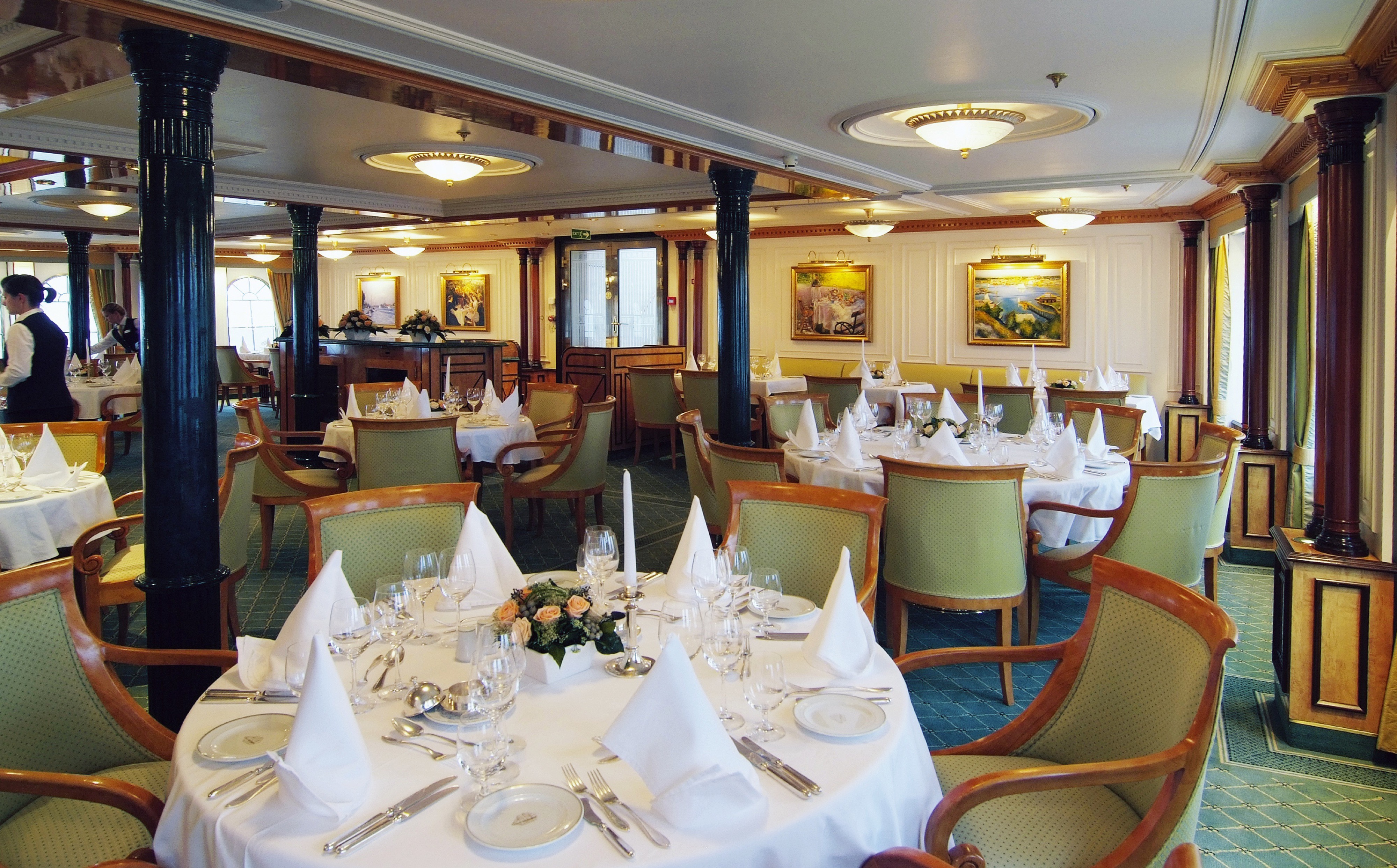
Restaurant
Meals are served on our ships in one seating. Service times can be found in the daily program on board. Please kindly note that reservations are not possible.
Our top-quality wines from well-known vineyards are often locally sourced. Our sommelier carefully selects each wine for every season and sailing destination. Wines are paired with lunch and dinner menus. In addition, you are always free to select your favourite wine from the menu.
A small breakfast with pastries and fruits is offered to early and late risers onboard the SEA CLOUDs. On board the SEA CLOUD II, a small breakfast is available at the Lido Bar. The main breakfast buffet is provided in the restaurant. Lunch is served as a buffet on the lido deck or in the restaurant. In the afternoon, coffee and tea are served, accompanied by some sweet treats and sandwiches. Dinner is a four-course menu with entrees to choose including a vegetarian option. Our executive chef will prepare an exclusive five-course meal for the gala dinner. A late-night snack nicely rounds up the evening’s culinary delights.

Lido Deck
You will find a dining area and Lido Bar on the Lido Deck.

Zodiacs
Zodiacs are small motor-driven rigid-hull inflatable boats with a capacity of approximately 8 to 10 guests, primarily used for beach landings on our cruises or our photo safaris.

Watersports
Water sport activities are offered from the gangway on the marina platform.
We do have snorkelling equipment in different sizes on board, stand-up paddle bards for beach landings and a towable tube from the gangway.
All water sport activities are included and subject to weather and Captains permission.
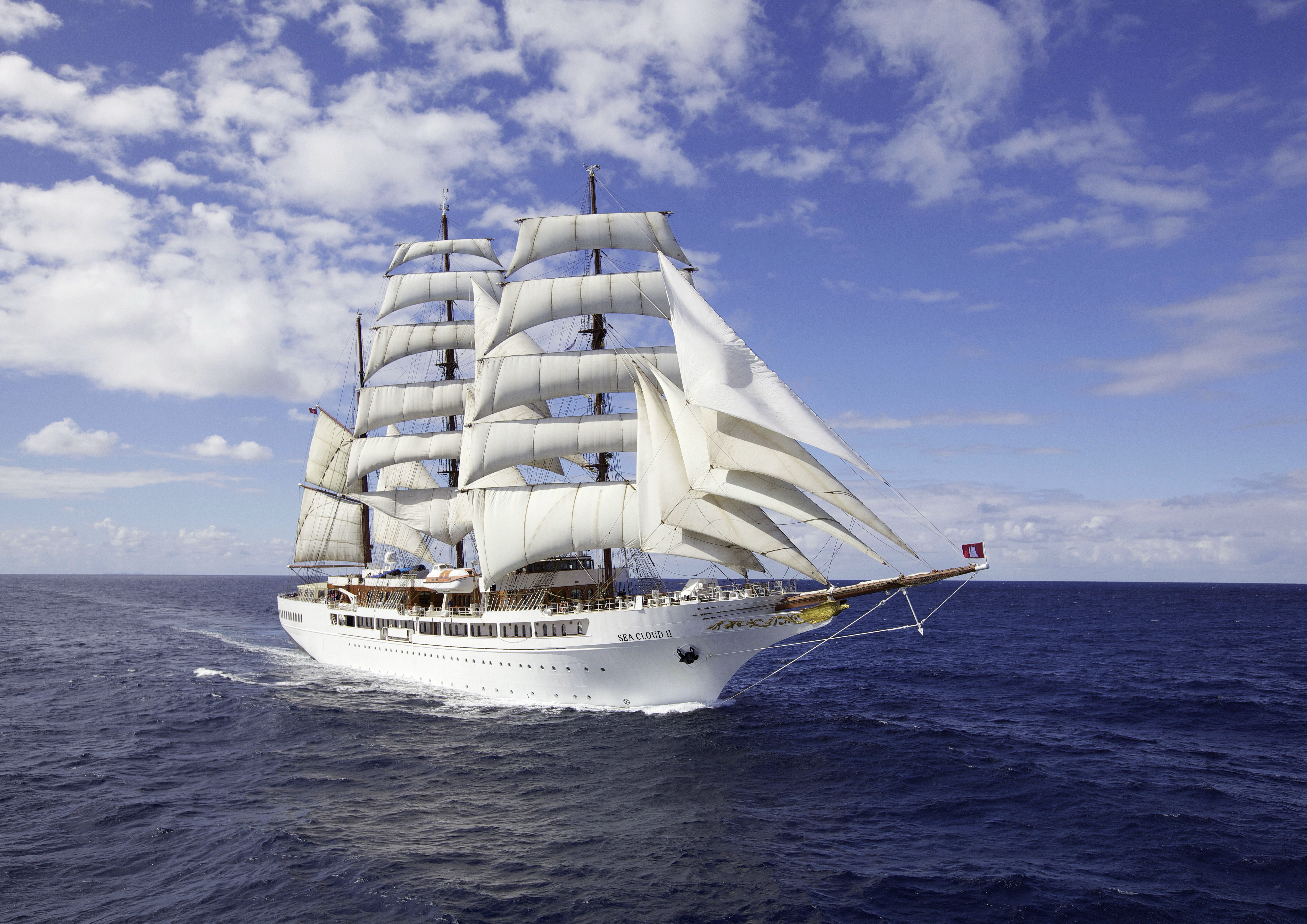
Excursions
All our shore excursions are shown on the itinerary pages of our brochure. 4 weeks prior to departure you will receive detailed information on shore excursions with your travel documents. The shore excursion booklet also includes the order form to pre-book your excursions. On board the Cruise Director will be able to provide further details during a lecture. We do recommend pre-booking prior to embarkation to secure your spot. All excursions will be charged to your cabin account on board.
You are free to join an organised shore excursion, stay on board or make individual arrangements. You will find times for tender or to be back on board in your daily program and at the gangway.
Please remember to bring comfortable footwear, a light jacket/windbreaker, as well as sunscreen where appropriate.
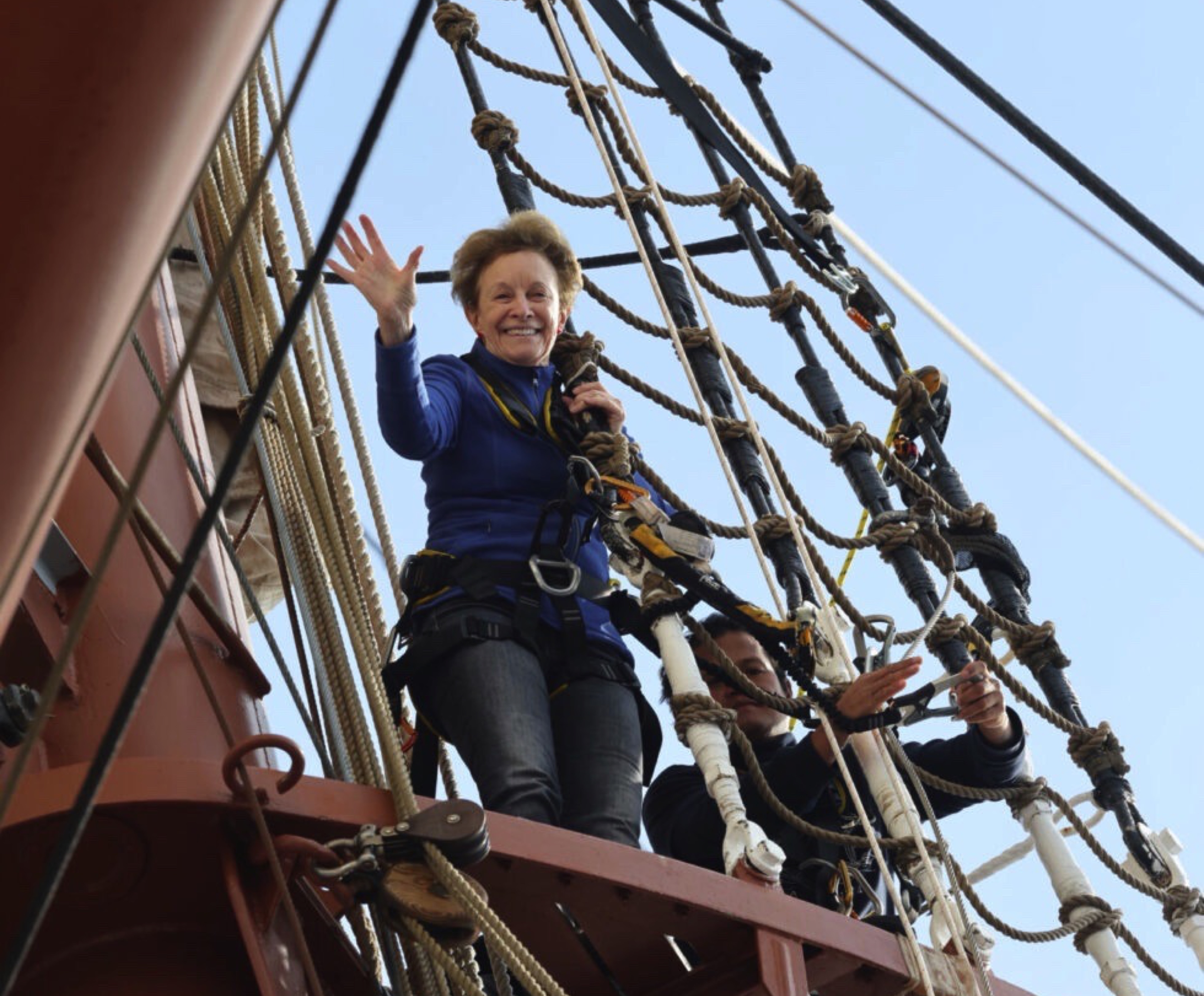
Rigg Climbing
Join us for some rigg climbing
One of the most captivating experiences onboard the SEA CLOUD windjammer is watching the crew climb into the rigging to set the sails by hand. Now, you can share a piece of this adventure yourself and – if your fitness allows – climb up to the first platform!
Our SEA CLOUDs are the only cruise ships in the world that are traditionally sailed by hand. Here, nothing happens at the push of a button: setting the sails follows centuries-old rituals, bringing the magic of sailing to life in a unique way. Now, you can experience this tradition up close! High up in the rigging, carried by the wind and with sweeping views over the sea, you’ll feel the majestic power of our tall ships even more intensely. Safely guided and equipped with state-of-the-art safety systems, you can climb up to the first platform, about 14 meters above the deck – an unforgettable moment for those seeking adventure!
A brief fitness check on board ensures that you feel completely comfortable and secure before you ascend. This includes: hanging from a bar for 10 seconds, balancing on one foot for 20 seconds and climbing stairs two at a time. Our experienced deckhands, specially trained for these activities, will guide you every step of the way so you always feel safe and well taken care of.
Embark on this unique adventure now – a once-in-a-lifetime moment that will leave you with a deep sense of joy and a touch of pride. Are you ready to experience the sea in all its splendour, high above the sails?

Lounge
The lounge is located on the Lido Deck (SEA CLOUD II & SEA CLOUD SPIRIT) and is always open. This is where all lectures take place and on select sailings concerts on the Steinway grand piano (SEA CLOUD II and SEA CLOUD SPIRIT). Enjoy a selection of games or just an afternoon snack.
The Lounge Bar is open daily from 11:00 am. All drinks, alcoholic and non-alcoholic are included, premium drink are at an additional charge.

Library
Our beautiful library offers a variety of English books, popular board games and DVDs (SEA CLOUD II only). You are welcome to take the books to your cabin during your sailing and return before the end of your cruise.

Lido Deck with Bar
The Lido is open daily from 11:00 am. All drinks, alcoholic and non-alcoholic are included, premium drink are at an additional charge.

Bridge
The bridge area can be visited during the day and/or at specified times, subject to captain’s approval. The bridge is closed during manoeuvring operations and night sailing.
Boutique
The boutique on our yachts offers accessories, clothes, and gifts. Opening hours vary. You will find the exact information in the daily program and on the public boards. Feel free to contact the reception with any questions or requests outside of opening hours.

Fitness and Sport
SEA CLOUD II has a fitness area on the cabin deck. The gym is open during the day and is equipped with a step machine, a bike, a treadmill, and a rowing machine.

Massage & Cosmetics
On SEA CLOUD II we offer massages and beauty treatments at an additional fee We do have a sauna on the cabin deck, which is heated upon request. Please contact the reception.
Special Dietary Requirements
Please inform us prior to your cruise if you have any allergies, intolerances, or other special dietary restrictions. We will try to accommodate your needs as far as possible.
Dress Code
During the day, we recommend casual chic, yachting clothes. The evenings are casual elegant. Please refrain from wearing swimwear during lunch and/or shorts at dinner. For the Captain’s Dinner (once or twice depending on lengths of the cruise), we recommend elegant cocktail attire, a suit or ensemble for the gentleman and matching dress for the lady. We additionally suggest bringing non-slippery boat shoes.
Disabled Access
Our windjammers, SEA CLOUD, SEA CLOUD II and SEA CLOUD SPIRIT, are not barrier-free and, therefore, unsuitable for wheelchair users. Please contact our reservations directly for details.
There are no elevators on the SEA CLOUD and SEA CLOUD II, only staircases. SEA CLOUD SPIRIT is equipped with an elevator. You will access and depart the ship via the onboard gangway, which is not always level. Depending on weather conditions, access might be steep. The tenders or zodiacs service is done via the gangway. Please contact us prior to cruise if you have any questions regarding accessibility. If you need specific medical arrangements, please contact us in advance.
Smoking Policy
Smoking is permitted only on the lido deck outside of mealtimes. We kindly request that smokers take the other passengers into consideration. Smoking is always prohibited in covered areas on the lido deck, of the spanker deck (SEA CLOUD), on the blue lagoon (SEA CLOUD II), on the sun deck and on the verandah (SEA CLOUD SPIRIT).
Internet Access
Each of our yachts is equipped with Starlink satellite internet. All three ships offer WI-FI access in the public areas and in the staterooms. You can use your own laptop to access the Internet with an access code (WI-FI). Data volume of 10 GB is free of charge; additional data volume can be obtained from the reception desk at a charge. Continuous reception cannot be guaranteed; in certain sailing areas or due to the set course, interruptions to network coverage might be experienced. The WI-FI connection on a ship is not comparable to the usual reception on land.
On board, a laptop that is located in the lounge (SEA CLOUD) or in the library (SEA CLOUD II & SEA CLOUD SPIRIT) can be used for e-mail use on board. The SEA CLOUDs have their own on-board email addresses as follows:
SEA CLOUD: seacloud@seacloud.com
SEA CLOUD II: seacloud2@seacloud.com
SEA CLOUD SPIRIT: passenger@scs.seacloud.com
Please advise anyone you give the above email address to not send messages with attachments. Please put your name and cabin number in the subject line to ensure that the reception can forward any correspondence to you. They will hand you a printout of the e-mail.
Incoming and outgoing e-mails up to 50 KB in size can be received or send free of charge. However, files larger than 50 KB per message are automatically rejected by the system.
Due to limited network availabilities at sea, cell phones use is limited. The SEA CLOUDs are equipped with Starlink that ensures WIFI connection. Phone numbers to reach the ship can be found in your travel documents and on board.
Laundry Services
Laundry services on board are limited to washing and ironing. There is no dry cleaning available. You will find a price list for the overnight laundry and ironing service in your closet. For guests who have booked a suite in category A-C (SEA CLOUD) or category A+B (SEA CLOUD II & SEA CLOUD SPIRIT) the laundry service complimentary. For safety reasons, passengers are not permitted to iron in their cabins.
Children on Board
Children are welcome on our ships, but please keep in mind there is no daycare or special entertainment for children on board our ships.
Sustainability & Low Impact Tourism
OUR CONTRIBUTION TO ECO-FRIENDLY TRAVEL
We approach the people and their cultures with respect in all the regions we visit, travelling mindfully through the local environment. By doing this, we can bring our guests closer – in the truest sense of the word – to these places, and what makes each one special.
THE WINDJAMMER EXPERIENCE
For you and us alike, the key attraction of our trips is the chance to sail on the open seas.
We therefore take every opportunity to set sail and be propelled by the sheer power of the wind. That is why the captain will sometimes change the route if the weather requires it. On board our SEA CLOUD tall ships, you’ll experience the elements, as many of the day-to-day activities take place outside.
HAVING AS LITTLE IMPACT AS POSSIBLE
When we do have to start the engines, we utilise low-sulphur marine diesel on all three of our windjammers.
For us, this is standard practice. Even the SEA CLOUD, our very first windjammer, was equipped with this technology right from the start. Our motto: to minimise our impact on the environment yet still make a profound and positive impression on those around us.
A SUSTAINABLE APPROACH TO LIFE ON-BOARD
Avoiding plastic, reducing water usage and protecting the environment.
These are the factors that guide us in the day to day operation of our ships and our ongoing development of eco-friendly alternatives. To cite just one example, our reusable drinks bottles are not only easy on the eye, but also easy on the environment.
QUALITY, NOT QUANTITY
Our ‘small but perfectly formed’ windjammers are able to visit smaller ports, away from the busy routes frequented by large cruise liners.
With a maximum of 64 to 136 passengers, we’re always welcomed in those locations thanks to our approach of visiting local communities rather than overwhelming them. Needless to say, our itineraries also include some classic destinations, though we usually visit these only when the mega-liners have moved on.
BOOSTING THE LOCAL ECONOMY
Procuring supplies locally, working with local, smaller-scale agencies and paying fair prices.
By taking this approach, we see ourselves as a partner for our local service providers, with whom we’ve built relationships based on trust over many years. After all, we want our voyages to benefit both our guests and the communities we visit around the world.
AUTHENTIC CUISINE
Our menus are always a true reflection of the regional cuisine.
This is because our chefs enjoy buying exotic spices, local specialities and freshly caught fish from local markets to bring you – even in a culinary sense – closer to the places we visit.
A MEMBER OF THE FUTOURIS NETWORK
Heading into the future with Futouris.
Preserving the natural and cultural heritage of our world and shaping the future of tourism in a sustainable way is what Futouris stands for. Members of the network are working globally to improve people’s living conditions, preserve biodiversity and protect the environment and climate.
Medical Facilities
All three ships have a clinic and a ship’s doctor. Medical consultation hours can be found in the daily program. In case of an emergency, the doctor can be reached at any time by calling 911.
What's Included
Complimentary with your sailing:
- Welcome champagne in suite/stateroom
- Daily fresh fruit basket in suite/stateroom
- All meals including nightly 4-course menu and a 5-course gala dinner
- Fine wines from renowned winemakers and beer for lunch and dinner
- All non-alcoholic coffee and tea specialties
- All soft drinks
- Welcome and farewell cocktail
- Bottled water on excursions
- Gratuities and port fees
- Curated moments
- Beach barbecues in select destinations
- Marina platform with use of water sports equipment such as snorkel gear, stand-up paddleboards, and towable tube (weather permitting)
- Laundry service in suites

Sun Deck
- Captain
- Bridge

Lido Deck
- Lounge
- Lido Bar
- Lido Deck
- Library
- Cat. A Owner’s Suites

Promenade Deck
- Restaurant
- Boutique
- Purser
- Reception
- Junior Suites
- Grand Staterooms

Cabin Deck
- Fitness Area
- Massage and Cosmetics
- Hospital
- Swim Platform
- Deluxe Stateroom
- Stateroom (Upper/Lower-bed Cabins)




